#it's in the other timeline and set in the 80s instead of the modern era
Note
drop lost truth au lore?
OH BOY DO I GOT SOME LORE FOR Y'ALL
i changed up some stuff for the zelda lore, especially the gerudo cause they're racist stereotypes so i can start with them.
they're a very successful community built on trading. everyone, regardless of their origins, are allowed into the villages. the current chief for the main village is named after one of the legendary seven sages, nabooru. she's trying her best to lead the village, especially after the betrayal of someone who she thought she could trust.
for what they wear, it's mostly clothing that can help protect them from the heat of the sun.
more lore stuff under the cut
Main Lore:
after calamity's defeat thousands of years ago, it lost all of its power and is now known as ganon once again. ganondorf has risen to power once again, killing off the current chosen hero and queen zelda before they could stop him. before he could get their triforces, however, they vanished. many assume they went to the new chosen ones. queen zelda's infant child was taken by impa and hasn't been heard of since. people and pokemon fled castle town to the other regions of hyrule to escape ganondorf's cruel reign. a toddler was left in the lost woods as their mother took her dying breath. meanwhile, a six year old child was enjoying her new reborn life (although she didn't know that yet).
years later, a ten year old is summoned by the protector of the kokiri forest, madame saria. she tells him of the legend and how he, a half-hylian half-kokiri child, was chosen to be the new bearer of the triforce of courage. he and his three pokemon travel to their first dungeon where the master sword would reside. in their, they would find an unconscious girl who had powers unknown to hyrule. she would be the one to step up as hyrule's princess as they both agreed zelda was much too young to bear responsibility.
ganondorf managed to travel to a different dimension in the years leading up to everything, kidnapping a great dragon who had the power of truth. as our heroes first encounter him, he reveals his plan to alter history and the truth. the dragon of truth begs them to free him as ganondorf drags him through the time machine. they follow after him in hopes to prevent the dark king from altering the truth. maybe they shall find their own truths as they try stop a man's cruel ideals.
-----------------------------------------------
okay so i don't really have kamitsure's lore stuff down yet but i do have some of kudari's down.
kudari originally goes by link before deciding to change his name, same as how kamitsure originally went by serenity. at first he has blond hair and blue eyes like the other link's but as the adventure continues, his hair and eyes become more and more silver. the reason he's half-kokiri is because he was taken in by the kokiri similar to how oot link was. he also has a magical flute so he can cast spells with just a simple song. he also learns a verrrry familiar song.
i'm thinking of doing some parallels with kamitsure and the past zelda's with how similar their stories can be (kingdom's being destroyed, sharing the same name, technically being the reincarnations of a goddess, etc.).
as for how the story would go on after kudari pulls out the master sword, he and kamitsure go on a trip to kakariko village. it's the closest to another village which has a tunnel that leads straight to castle town. they stop by lon lon ranch along the way and they meet psyche, anzu, and arakan. psyche takes care of a particular ponyta called epona and teaches them her song and gives important information. you must have a starter pokemon if you want to be allowed into the village the leads to castle town. luckily kakariko has a professor who gives them their starters and registers them as trainers. the professor also gives them phones with built in pokedexes.
there are cooldown periods for the time machine that allows them to go out and explore hyrule. this allows them to get upgrades from the great fairies and restock. it also allows them to get to know the other kingdoms and gain their trust for their final battle against ganondorf.
dungeons that they need to defeat are spread across their own hyrule and the others. at the end of every single one is a pokemon familiar to kudari and kamitsure that they must free. those pokemon will then join their group and help them. they'll also catch their own pokemon throughout the journey as well.
by the end of the journey they'll each have more than six pokemon on their teams.
i think humans and pokemon fight alongside each other. like, they fight together to defeat a monster. it gives a chance for awesome combo moves. also there's mega evolution, z-moves, and dynamaxing are a thing.
anzu and arakan are kinda like battle facility heads despite being six year olds. kudari and kamitsure train alongside them to grow stronger alongside their pokemon and to build trust with their teams.
this is all i have that isn't super major spoilers so far. it's kinda all over the place but soon i'll have a google doc so i can then organize everything. i'll leave a list of the current major rulers and the pokemon they have alongside the pokemon kudari and kamitsure will have by the end of their journey.
King Sidon II, King of the Zora. He has a Primarina and a Gyrados.
Daruk, Leader of the Goron. He has a Gigalith and a Rhyperior.
Nabooru, Chief of the Main Gerudo Village. She has a Gardevoir and a Lilligant
Revar, Chief of the Rito. She has a Talonflame and a Corviknight.
Princess Serenity/Kamitsure, Princess of the dead Moon Kingdom.
Zebstrika (Alpha)
Emolga
Emolga
Flaafy
Joltik (Alpha)
Empoleon
Mismagius
Electivire (Alpha)
Stunfisk
Kudari, Hero of Truth.
Sylveon (Alpha)
Hisuian Zoroark ("Alpha")
Driftblim
Luxray
Crobat
Joltik
----'s team
-----' team
Hisuian Typhlosion
Rapidash (Technically, Epona is Psyche's Pokemon)
Parasect
Lopunny (Alpha)
Vespiquen
Hisuian Goodra
--------
#the ask box has been fed#ace rambles about aus#phonetically-phlustred#lore dump#the legend of zelda: lost truth au#subway boss emmet#subway master kudari#kudari#gym leader kamitsure#gym leader elesa#kamitsure#submas au#they do delve into the different timelines and stuff#by their point in history the timeline split twice and they're still split so there's another zelda dimension that's close to theirs#it's in the other timeline and set in the 80s instead of the modern era#anyways fairies love kudari and will always follow him#also there's a reason why they're even in the loz world in the first place other than that hylia just wanted them there#it's really dark though#submas#i'll post what they look like as soon as i draw them
5 notes
·
View notes
Text

a random assortment of open verse headcanons for akaza , douma , gyuutaro ( npc daki included ) , muzan kibutsuji , rui & new muse enmu .
because i have muses from the manga involved in these headcanons , be weary of the ones you aren’t familiar with as they do spoil a lil bit of season 2 ( specifically for gyuutaro & douma ) , but not that much . if you do not mind spoilers for demon slayer , you may proceed with no caution !

general info :
considering the timeline of demon slayer ( taisho era : 1912 - 1926 ) , i’ll be adding an extra hundred years to their chronological age to keep their origins as close to canon as possible .
missing person ? 9/10 times a demon ate them !
though the majority of the hc’s are carefree & light hearted — due to the nature of the series , general discussion of violence , mentions of manipulation & cannibalism will be present .

akaza
attending night school & taking some classes online , akaza recently started high school again as a student in his final year ( has done this around the 80s under a different alias & appearance ) . he is known for skipping classes & starting fights with other students . he has a jotaro kujo type of rep at his school .
he doesn’t really care about school all the much — mostly attending to play some kind of role in modern day society .
on the topic of fights , he often looks for them in the night life areas of the city — somewhere he can find a group of people to brutalize . he leads them to places where he can ( of course ) kill them without the possibility of prying eyes .
he has a soft spot for animals ! one rainy day , he found a stray cat & decided to take him in & raise a lil guy ! his name is hanabi .
he drives a motorcycle . what kind ? not sure yet !
on more than one occasion akaza beats the shit outta guys who stalk or harass women in many ways . this has led him to getting random gifts of gratitude when they find him again — stuff he REALLY doesn’t want to accept , but does to show show thanks .
really wants a hedgehog .

douma
he is still a cult leader in the modern day , but does other things on the side ! his cult looks a bit different than it did in the past . it’s recognized as a more of a spiritual group or collective revolving around self improvement , rather than a religious group or something .
he also plays the role of a swindler , sweet talking his way to riches & increasing his follower count .
aside from the fact that he HAS to be out at night , he really does enjoy the night life . the lights are exciting & the general atmosphere of people having a good time suits him .
enjoys going to a particular coffee shop on cloudy or rainy days , though he only goes there to sit in the lounge & not drink the coffee . buys sweets here & there then offers to pay the person behind him a treat too ( he’s really flirty with people ) .
for the past hundred years , douma has expanded on his collection of skulls from his victims . he has found an interest in morbid occult things , such as ; specimens ( animal skulls , animal organs , animal parts in general , bugs & other oddities ) , shrunken pygmy heads , taxidermies & other things of this nature .
he is extremely fascinated with other cultures & how they deal with dead bodies & has spent years researching about it . what is he looking at in those cafés ? possibly morbid shit ( he’s got a vpn ) ! because of this , he really wants to visit egypt to see a mummy .
kinda wants to attempt mummify someone or turn then into a taxidermy . maybe a doll .

gyuutaro & npc daki
going off of the lil extras that are provided at the end of each book , gyuutaro — like akaza , goes to night school & rides a motorcycle !
in japan , there are these services where you can pay to go out on a date with someone . daki does this instead of being a courtesan .
gyuutaro always stalks her while she goes on these dates so no one does anything that wasn’t agreed upon .
being the one who counts the money she earns , gyuutaro is really REALLY good at math . on that note , his organization skills when setting up an equation — PERFECT ! he’d be a perfect accountant !
on that note ... daki is sooo confused with that stuff . she’s not very good at math & would ask for his help but it would always end in a shouting match .
gyuutaro wears a mask to cover his face whenever he leaves the house in his human form . this is mostly to cover his face because he’s insecure about his appearance .
when paying for something gyuutaro has to build up the courage before he approaches the cashier .

muzan kibutsuji
muzan still out here living multiple lives ! one of which , a young gothic lolita who was adopted by a socialite family .
muzan is one of the few demons who leave while it’s a partly cloudy day . he uses a cute goth lolita parasol to reflect the sun !!
this persona , he goes by the name of keina ( last name wip ) & is considered to be a prodigy in replicating the art works of a famous pottery artist in the tiasho era ( this is reffering to gyokko who still makes pots for muazn to take credit for under the guise of keina )
in the persona muzan has when he is a young man he is the owner of a museum .

rui
rui is one of the demons that hasn’t really adapted to modern society . while he knows about cellphones , the internet & all that — he doesn’t really care to move to the city .
his presence & house in the forest is recognized as a famous urban legend on the internet : one about people who get killed by the ghosts that haunt the area . the general public believe that people just go missing or presumably get killed by wild life or eventually succumb to the elements .
while he doesn’t go into the nearby town too often , he does just to wander on occasion & doesn’t mind being spotted by people ( they often run from him thinking he’s a ghost ) .

enmu
enmu still works as a hypnotherapist who eventually tortures & eats his patients but he also finds his victims at places like train stations ( a place he likes to be for some reason ) .
enmu has a fascination for trains & you bet he collects train models . big big fan of those lil models .
he loves watching disturbing movies . while he is very chill about most things , this is possibly one of the few things he can get serious about . yes , knowing that the things that are happening in the movies are fake , but a movie with good acting that appears believable — he absolutely loves . what he loves more is showing the average person to watch their disgusted reactions .
& yes , he likes disturbing movies but there are some he does view as trash because is wasn’t good in his eyes . A Serbian Film would fall under this category for him .
this is him — THIS POST IS ENMU !!
he was a theatre kid . he likes musicals a TON !
has a pet spider , mostly to disturb certain guests . even inciting the most subtle disturbing feeling in someone is ecstasy for him . it’s like playing mind games with them , the way he treats every interaction .
he actually has obsessions with idols & collects albums , posters & the like of his favs . if he could , he would turn his favorite idols into demons & have them serve him ( kinda like rui’s situation with his family — though enmu would be far more cruel & subject them to more torture ) .
13 notes
·
View notes
Text
WandaVision series review part 2.
Last week, I posted part 1 of my WandaVision series review, containing my initial thoughts and breakdown of episodes 1-3 (part 1 can be found here). This post, part 2, will contain my breakdown of episodes 4-6, and part 3, to come next week, will contain episodes 7-9 and my final thoughts.
So, let’s go.
Episode Four: ‘We Interrupt This Program’
This is the episode where everything comes together; where things start to make sense. This episode debuted on January 29th, finally giving us some answers after the first and second episodes were released on the 15th. It has a runtime of 34 minutes, which is fairly on par with the episodes up to here, though this episode doesn’t follow the sitcom format, but feels more like your classic MCU content.
The episode opens with a previously on WandaVision recap, which seems to very much focus on Geraldine, the meaning of which soon becomes clear. And we enter a black screen which slowly fades into the form of Geraldine, with voices from the movie Captain Marvel--the voices of Carol Danvers, Maria Rambeau and Maria’s daughter, Monica, which just confirms fan speculation that Geraldine is, in fact, a grown-up Monica Rambeau, and we must currently be seeing her after the Blip--after Bruce Banner’s snap in Avengers: Endgame returned all those Thanos killed at the end of Avengers: Infinity War.
Monica sits in a hospital room, but the bed beside her is empty, then she leaves the room to panic as people coalesce throughout the hospital. She asks about a patient in room 104, then one of the doctors recognises her, and tells her her mother--Maria Rambeau--who presumably was who she was in the hospital for, is dead, and about the Blip, because it seems to Monica it’s only been a few minutes. And we have the Marvel logo, after an introduction instead of right at the beginning as in the sitcom episodes.
Cut to the headquarters of SWORD, standing for Sentient Weapon Observation and Response Division, which is quite clearly just talking about Vision. Honestly, though, Marvel’s obsession with making their acronyms real words--I’m talking to you, SHIELD and HYDRA--is mildly irritating because of how unrealistic it is. Just a me-gripe.
Monica fails to access the building, her badge apparently outdated, and we’re introduced to Tyler Hayward, acting director of SWORD in Monica’s absence. Hayward brings her into the building and declares Monica grounded, able to only carry out terrestrial missions, on her mother’s order for if the personnel who disappeared in the Blip were to return. He then assigns her to an ‘FBI thing’. Cue the wonderful Jimmy Woo.
Monica is welcomed near the sign for Westview by Jimmy Woo, the FBI agent who dealt with Scott Lang’s house arrest in Ant-Man and the Wasp. Jimmy tells Monica a witness he had in Westview has gone off the radar; that everyone seems to have forgotten the man’s existence. And they approach two policemen stood by the sign, who claim Westview doesn’t exist. Ah, Wanda’s lovely magic. Jimmy also says he can’t contact anyone on the inside.
‘This isn’t a missing person’s case, Captain Rambeau, it’s a missing town. Population 3,892.’
And Jimmy claims the town itself won’t let him in to investigate, but though the town seems empty, it is visible, and there doesn’t appear to be any physical barrier. Monica sends in a helicopter-style drone, and the camera feed glitches like a television screen as it nears the town, then the drone disappears--the toy helicopter Wanda found in episode 2. Monica approaches the town, and a television-barrier becomes apparent. Monica touches it, and is pulled inside, hence becoming Geraldine within Westview in episodes 2 and 3.
Cut to a day later, the glorious Darcy Lewis from the first two Thor movies, Jane Foster’s (Thor’s love interest’s) intern, now graduated and with a PhD in astrophysics, sits in a van with several other scientists of different fields. Outside Westview, SWORD has set up a kind of military base. Darcy takes some readings and gets ‘a colossal amount of CMBR’ (Cosmic Microwave Background Radiation, which is one of the things used to prove the Big Bang Theory), and notices ‘longer wavelengths superimposed over the noise’, and has the idea to set up and link a vintage television to it.
Cut to night, we watch a man in some kind of protective suit crawl through sewers into Westview, the border of which transforms him into the beekeeper from the end of episode 2 which prompted Wanda to rewind and skip to the 1970s.
Darcy’s TV picks up the signal, and plays the previous episodes of WandaVision in their sitcom format, pointing out Vision is meant to be very, very, very dead. We see that the hands the camera zoomed out to reveal watching the show at the end of episode 1 belong to Darcy.
At this point, SWORD starts putting together a wall and whiteboard of their information, and it’s really fun to see them asking all the same questions we as an audience are. Why hexagonal shape? I take it this means the border is hexagonal, not that we’d know that as an audience. Why sitcoms? I know the answer, but only because I watched episode 8 already. Same time and space? and, of course, Is Vision alive?
It’s really fun knowing the answers.
Jimmy and Darcy watch Monica as Geraldine, and question whether she’s playing along or if she’s oblivious. With some science-y Darcy stuff, we also see that the voice in the radio in episode 2 was Jimmy, but we see the episode glitched itself out of that situation, like what SWORD is calling the ‘Westview anomaly’ is righting itself when they interfere.
As they watch Wanda give birth, they expect the anomaly to break, as all the other people are real people brainwashed, but then the babies are born, indicating Wanda has some kind of creational power (foreshadowing). Geraldine mentions Ultron, and as Wanda tells her to leave, the episode again glitches to the credits, not quite as we saw in the actual episode.
It then cuts back to that scene in episode 3, but not through the old TV as Jimmy and Darcy are watching. I didn’t notice whether or not it did this in episode 3, but the aspect ratio has increased, more to that typical of a modern show, in contrast to the smaller ones of the early sitcoms. And we watch Wanda threaten Geraldine with her magic, glowing red as it should--the event episode 3 emitted, instead giving us Vision’s perspective. Wanda tells Geraldine to leave, and blasts her through the walls of the house, and straight out of Westview, hence the end clip of episode 3. Wanda repairs the wall just before Vision returns home.
Something curious though--we know when SWORD sends things, including people, into it, they transform to fit the style, like the drone becoming a helicopter, the man becoming a beekeeper and Monica’s style changing to fit the decade, but when Monica comes out of Westview, she still looks like she did in the 70s episode.
Cut back to Wanda inside Westview, and she sees Vision walking, but apparently dead; skin-tissue-stuff pale, eyes blank and a hole in his head where Thanos took the mind stone, but he acts normal. Then Wanda sees him again looking normal. Vision tells her they don’t have to stay here if they don’t want to, and Wanda replies that they can’t; that this is their home--’Oh, don’t worry darling. I have everything under control.’ Which affirms Geraldine’s claim at the end of episode 3, that it’s all Wanda. (I’m going to refer to her as Geraldine when talking about episodes 1-3 and Monica when talking about 4-9, even though it’s the same character.)
Wanda and Vision sit down to watch TV and the credits begin, though Vision seems a little apprehensive.
And we finally have some answers about what the hell has been happening in Westview, and the vaguest idea how it fits into the MCU timeline as a whole.
Episode Five: ‘On a Very Special Episode...’
This episode was released on February 5th, with a runtime of 41 minutes, longer than any of its predecessors but still not exceptionally long. This is likely so it can follow the 1980s sitcom format with the inclusion of the SWORD parts. Note at this point, when the decade shifts, it occurs as something goes wrong: we shift to the 1960s when Mr and Mrs Hart question Wanda and Vision about how they came to Westview; we shift to the 1970s when they see the beekeeper, and we shift to the 1980s as Wanda forces Monica out of Westview.
So, we have the recap; nothing particularly noteworthy about it or its focus.
Shit, I just realised Tony’s snap at the end of Avengers: Endgame is now part of the Marvel logo sequence. Ouch.
Music plays, and we open to Tommy crying in a 1980s-style house. This episode is mostly formatted off Full House, in which Elizabeth Olsen’s elder sisters, identical twins Ashley and Mary-Kate Olsen, played the youngest daughter, Michelle Tanner. Unrelated to the plot, but a fun aspect.
Billy and Tommy won’t stop crying, so Wanda tries to force them to sleep with her powers, but it doesn’t work, and we still don’t see the red sparks, but, again, that’s an 80s-style special effects thing. Also, aspect ratio in this episode: a little larger than in episodes 1-3, but not quite episode 4′s. Funny thing here is that episodes 1-3 were shot and edited in such a way the episodes registered on Disney+ as having a larger ratio, giving a black border around the frame on the screen, but it doesn’t have that in this episode. Just a technical thing I’m not sure of the cause of, though in retrospect may simply be to convey the size of TV screens in the eras.
Also, can we take a moment to appreciate Wanda’s curly hair and floral waistcoat in this episode?
Agnes shows up to help them with the babies, to which Vision is apprehensive, and after a moment, she says to Wanda: ‘Do you want me to take that again?’ as though they’re following a script. This continues, Agnes asks if they should take it from the top, which confuses Vision, but Wanda just laughs it off. This is interesting, because the only other person we’ve yet seen break character is Geraldine, who entered the anomaly after its initial formation. Then Agnes shifts back into character, and the laugh track picks up again.
Vision questions Agnes’s comments aside with Wanda, but Wanda brushes it off, and acts as though nothing happened, and his suspicion only grows.
Then suddenly the twins are about... five? I’d say five. I don’t know. As Wanda and Vision realise this, Agnes says, ‘Kids. You can’t control ‘em. No matter how hard you try.’ There’s a running theme of children in this show--obviously the children themselves, ‘for the children’ in episode 2, and Mrs Hart’s questioning of when they were going to have children in episode 1. This semantic field fed theories that Wanda was literally doing this ‘for the children’, and this comment from Agnes could suggest the children will be the downfall of the anomaly--Wanda brainwashes the adults, but not the children.
The introduction to this episode is really cute. It has a mellow pop song playing over the top, and the 80s thing of using old photos of the characters; they’ve used actual photos of Elizabeth Olsen and the actors playing the twins, and mildly horrifying photoshopped versions of Paul Bettany as a child, but made into Vision. These photos of Vision were leaked before this episode came out, and it’s just hilarious to me because Vision was born an adult. And, assuming WandaVision takes place in 2024, after Avengers: Endgame and Spider-Man: Far From Home, Vision is literally nine years old as it takes place.
There generally isn’t much to pick apart in the theme songs themselves, but the general idea of this one is ‘we’re making it up as we go along,’ which could be an interesting insight into Wanda’s state of mind--we’ve somewhat villainised her up to this point, creating the anomaly and controlling people, but the stance should be taken that she just doesn’t know what she’s doing, and is trying her best, selfish as her goals may be.
Cut to Hayward questioning Monica about her memories, and she describes a hopeless feeling--grief--controlling her--Wanda’s grief at the loss of Vision in the fight against Thanos. They take some kind of scan of Monica’s body and draw blood, but have to redo them because the results came out blank--foreshadowing.
Hayward describes Wanda as ‘the principal victimiser’ instead of one of the victims of whatever was happening in Westview, jumping straight to villainous conclusions.
A point here: in a recap of the ‘subjects’, Jimmy Woo states Wanda was born in 1989, which is actually a change to canon, because in the events of Avengers: Age of Ultron, set in 2015, she was 16, born in 1999. Questionable. Still not sure why they did this, but this makes her 29 in WandaVision, excluding the years of the Blip, where she would otherwise be only 19.
Hayward asks Jimmy if Wanda has an alias--in the comics, Wanda Maximoff is Scarlet Witch, but this alias has not yet been stated in the MCU--foreshadowing. Hayward focuses on her failures, such as working against the Avengers upon her introduction and the destruction she caused in Nigeria at the beginning of Captain America: Civil War. He then calls Wanda a terrorist based on how Monica described her experience in Westview.
Hayward then reveals to us footage of Wanda entering the SWORD headquarters where Vision’s body was kept, and shattering glass to access it, broken into pieces, as though to steal it, which Jimmy doesn’t believe because it’s a violation of the Sokovia Accords, and Darcy wonders what will happen when Vision learns the truth.
Wanda comes into the kitchen to find Tommy and Billy with a dog they found and want to keep. Wanda is apprehensive about letting them keep him, Agnes shows up with a dog house, and Wanda decides to create a dog collar, right in front of Agnes. Vision calls her out on this, and she says she’s ‘tired of hiding’. They name the dog Sparky, then Wanda sides with Vision that the twins aren’t old enough to care for him until they’re ten years old, to which they just age themselves up again. Agnes jokes that the dog should stay the same size, but still doesn’t question the magic.
A note here: Wanda skips decades when things don’t go her way, and the twins skip ages--Wanda is in control of the things around her, but not herself, as they are in control of themselves.
Meanwhile, Monica tries to figure out how she could re-enter Westview, and Darcy starts to call the anomaly the Hex because of its hexagonal shape. And they discuss that Wanda must be wielding ‘an insane amount of power’ to maintain the Hex and the twins, beyond anything she’s ever displayed before. Monica mentions she could’ve taken down Thanos on her own if he hadn’t used the infinity stones, and Jimmy mentions he thinks Captain Marvel came close, to which Monica stiffens, and dismisses the conversation about her--something has clearly happened between Monica and Carol since the events of Captain Marvel.
They go a lab to run an analysis on the 70s clothes Monica wore when she came out of the Hex, and discover they’re bulletproof, like the vest she wore when she entered, and they establish Wanda isn’t creating anything, but is rewriting reality.
Vision goes to work, where he helps his co-worker Norm with his computer, and they get an email from SWORD about Westview, mentioning Darcy and radiation. Everyone in the office reads it out with Norm, but they laugh at it, while Vision is suspicious. He turns off the computer with his powers, then does the same zap-thing to Norm, who suddenly comes back to his regular consciousness, outside of Wanda’s control, and begs for help. He tells Vision he has to stop ‘her’, that ‘she’s in [his] head’. Vision zaps him again, and he goes back into sitcom-brain.
Wanda tells the twins Vision went to work, which they question because it’s Saturday. Wanda tells them he just needed a distraction because they weren’t ‘on the same page’. She talks about family, and tells them that her on brother is far away.
Sparky the dog barks at something outside, and we cut to a drone’s view. Monica has sent in an 80s drone, something the Hex wouldn’t need to rewrite, and we see that’s what Sparky barked at. Monica tries to speak to Wanda, and through the drone’s view, but not the broadcast’s, her eyes turn red, and Hayward orders an operator to ‘take the shot’, though Monica didn’t know it was armed. They take the shot and the drone’s camera cuts out. Alarms blare, and a worker claims ‘there’s a breach.’
We go outside to the border, and Wanda exits the Hex, wearing what she wore in the climax of the Infinity Saga, dragging the drone behind her. This is confusing to watch back, because I know in retrospect she wore civilian clothes when the Hex was created, and was left in them when it was destroyed. Shooters aim their guns at her, and she throws the drone to Hayward’s feet. As she talks, what she had elft of her accent in Avengers: Infinity War has returned. She tells them to ‘stay out of [her] home,’ that ‘if [they] don’t bother [her], [she], won’t bother [them].’ Monica talks to her, and she prepares her magic. Monica asks what she wants, and she replies ‘[she has] what [she wants]. And no-one will ever take it from [her] again.’
And ‘for the children’ clicks--Wanda clearly created the Hex to have a life and a family with Vision. Wanda uses her magic to turn the guns onto Hayward, but they don’t shoot as she returns to the Hex.
This scene is important, because it shows us for certain that Wanda is aware of what she is doing, and shows for certain that she is in control, where before we had substantial evidence, but nothing this undeniable.
And cue this episode’s advert, for Lagos Brand paper towels--’For when you make a mess you didn’t mean to.’ This is a reference to an event at the beginning of Captain America: Civil War, in which Wanda accidentally killed twenty-six civilians in Lagos, Nigeria.
We cut back to the Hex, where Sparky has disappeared. They cross paths with a mailman, who says ‘Your Mom won’t let him get far,’ another subconscious reference of one of Wanda’s cast to her control. They find the dog dead in Agnes’s yard, who says he ate her azaleas, which poisoned him. The twins are upset, but Wanda stops them aging up, and gives them a lecture about grief. One of the twins tells her she can ‘fix the dead,’ which Agnes does question. This is a reference to her apparent resurrection of Vision, but Wanda tells them death is inevitable and forever; blatant hypocrisy.
Later, Vision asks Wanda how the boys are, and Wanda says ‘life moves pretty fast out in the suburbs’, a reference to the show’s time-jumping. Vision tells Wanda of his conversation with Norm, and tells her he was in pain. Vision says ‘You can’t control me the way you do them,’ to which Wanda replies, ‘Can’t I?’ and the credits roll, but sitcom-style credits, not the WandaVision credits.
Wanda tries to leave, and Vision asks about the ‘Maximoff Anomaly’, but she feigns ignorance. He accuses her of controlling the town, the credits stop, and they rise into the air with their powers. Wanda says she did it for both of them, Vision asks what’s outside of Westview, but she doesn’t answer. Vision says he can’t remember his life before Westview, but Wanda reassures him that he is her husband and a father; he asks why there are no other children in Westview, which she again dismisses. Wanda exaggerates the insanity of what he thinks--gaslighting--and says she doesn’t know how it started in the first place.
The doorbell rings, which she says she didn’t do, and Wanda opens the door to Pietro Maximoff, the brother who she claimed was ‘far away’, but we know to be dead. Except it isn’t Aaron Taylor Johnson’s Pietro, from Avengers: Age of Ultron, and it’s not just a recast. He’s played by Evan Peters, who plays the version of Quicksilver in the X-Men movies, which is clearly intentional.
This led to speculation about the opening of the multiverse, and even though WandaVision doesn’t directly go that route, Wanda’s next appearance is going to be in Doctor Strange in the Multiverse of Madness.
This episode was an excellent one, and we’ve truly begun to build towards the climax.
Episode Six: ‘All-New Halloween Spooktacular!’
Released February 12th, this episode has a still-leaving-a-lot-to-be-desired 37 minute runtime, and is one of the ones primarily featured in the trailers, which showed Wanda and Vision dressed in mock-up costumes of their character design in the comic books, which is especially exciting for Wanda, because, not only has she not yet been officially called ‘Scarlet Witch’, she also hasn’t had an official costume, with most of her other outfits in a darker red, but not the comic Scarlet Witch.
Recap of the relevant information, roll the Marvel logo, and this episode opens with a fast-paced theme song, which shows Wanda for the first time with the red effects of her magic in the Hex through the sitcom camera. This song mentions ‘illusion’ again and again, then moves into a rather elongated verse of repeating ‘let’s keep it going’, implying Wanda is now simply trying to extend the time she has with her family.
The twins introduce the episode in that 1990s break-the-fourth-wall style, they play with Pietro, and Wanda comes downstairs in her costume, claiming to be a Sokovian fortune teller. Pietro says it’s ‘worse than the costumes Mom made us the year we got typhus,’ and we cut to a really brief flashback of Wanda and Pietro trick-or-treating; Wanda has her hair in a braid and Pietro has an eyepatch, which some thought might just be an Easter egg of the two dressing as Black Widow and Nick Fury, but looking at it now, it seems more incidental.
Vision then comes downstairs in his costume, and says he’s only wearing it because Wanda took all his other clothes out of his closet, and that it’s a Mexican wrestler. He tries to leave for the neighbourhood watch, to which Wanda starts, ‘No, that’s not what you’re supposed to--’ as though she’s beginning to lose control over the Hex. Pietro dresses in a mock-Quicksilver costume, and dresses Tommy in something similar, referencing that Tommy, in the comics, also has superspeed.
Wanda tries to test Pietro on a memory of their childhood, which he calls her out on, and she asks why he looks different, but he says ‘you tell me’, again implying this is her doing. Wanda talks to Herb, one of the neighbours and a member of the watch, who tells her Vision isn’t on duty.
Cut to Vision near the edge of town, and he sees people in their yard repeating the same motions over and over, as if Wanda has less control over the outskirts of town.
Cut to this episode’s commercial: this one is animated, of a boy of a deserted island, and a shark jumps out of the water, and gives him a ‘Yo-Magic’ yoghurt to eat, which the boy takes, but is too weak to open. Time passes, and we watch him starve--’Yo-Magic! The snack for survivors!’ This could be referring to Wanda’s inability to save the people around her with her magic--she couldn’t save HYDRA’s other test subjects, then she couldn’t save Pietro, then Vision.
Wanda asks Pietro what happened to his accent, and he asks her the same question, then tells her his memories are fuzzy. Tommy then goes to get candy, and reveals his superspeed powers. He and Billy then go off with a promise not to ‘go past Ellis Avenue.’
Darcy, Jimmy and Monica hack into Hayward’s data, and discover he figured out a way through the boundary, and that he’s tracking Vision and the people in his vicinity. They notice the people at the edge of town are hardly moving. Cut to Vision, who realises the people even further out are completely stagnant. He then morphs from his human costume to his typical Vision-self, flies upward and observes the town, noticing a car at the edge, which he flies down to.
We see Agnes in the car, dressed as a witch and still, but not unresponsive like the others. She tells him she got lost--’In the town you grew up in?--and he zaps her the way he did Norm in the last episode. She recognises him as Vision, an Avenger, but he doesn’t know what an Avenger is. She tells him he’s dead, and explains Wanda’s control, then laughs manically until Vision zaps her again, and she once again becomes the Nosy Neighbour, then turns the car and drives away. We zoom out to the street sign: Ellis Avenue.
Darcy sees Monica’s bloodwork in Hayward’s files, and tells Monica she can’t go back into the Hex as she wishes, because she’s already been through the boundary twice, and had her cells rewritten molecularly--Ms Marvel!! But Monica dismisses it, and tells Darcy she won’t stop until she helps Wanda.
Pietro accuses Wanda laughingly of only avoiding traumatising the town’s children by only bringing them out for a holiday cameo, but praises her, because ‘Families and couples stay together, most personalities aren’t far off from what’s underneath, people got better jobs, better haircuts, for sure,’ and tells her he’s impressed, but asks how she did it, which she doesn’t answer, then tells him she doesn’t know how she did it. She just remembers loneliness, and numbness.
She then looks back to Pietro, and sees him with bullet wounds in his chest; dead the way she saw Vision in episode 4, but she blinks it away.
Darcy watches Hayward’s tracking of Vision, and he approaches the barrier, sees it in all its television glory. Then he pushes through. He strains to make it through, and SWORD agents pull up on the other side. He nearly makes it, cape all that’s left, but it clearly painful, and he falls to the ground. Chunks of him tear off and fly back through the barrier. Meanwhile, Billy realises something is wrong with an echo of Wanda’s power, hearing Vision’s yells, and runs to Wanda.
Hayward handcuffs Darcy to stop her trying to get him to help Vision as he comes apart. Wanda asks Billy where Vision is, to which Pietro says, ‘Hey, don’t sweat it, sis. It’s not like your dead husband can die twice.’ Her eyes turn red and she sends him flying into a haystack. Billy focuses, and sees the SWORD soldiers, says he thinks Vision’s dying, and Wanda freezes everything around her, then sends out a blast of power.
Outside, the boundary of the Hex moves, expanding, and the SWORD agents panic to get away as Vision is re-encapsulated, but Darcy is handcuffed, and t passes over her. The SWORD camp turns into a circus, but Hayward, Monica and Jimmy get away--slightly wondering why Monica tried to when she was trying to get back in.
And the episode ends there. I don’t really have much of a conclusion to this episode--in truth, not too much actually happened aside from Pietro and the twins, but we are so building to the climax. This is also actually furthered by the absence of a laugh track in this episode, though this is also due to the fact they became less common.
And that summarises my breakdown of episodes 4-6. Part 3, with episodes 7-9, will come next week!
#wandavision#marvel#mcu#avengers#marvel cinematic universe#disney#disney plus#disney+#the avengers#wanda#wanda maximoff#scarlet witch#vision#quicksilver#pietro maximoff#the vision#maximoff#tv review#show review#programme review#program review#tv show review#movie review#movies#books#tv shows
2 notes
·
View notes
Text
Reappraising Companions
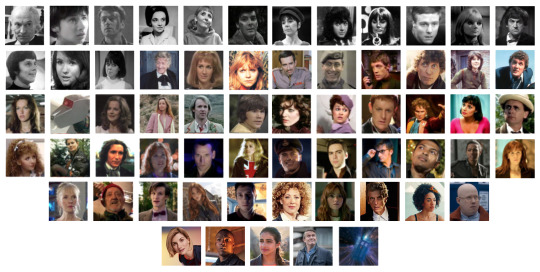
Years after having watched every available episode of Doctor Who, I've had plenty of opportunities to rewatch episodes time and time again. As with most movies and television, I've found revisiting certain stories and eras has caused me to see them in a different light. A story I may have once reviled is suddenly more interesting. I even came to appreciate Peter Davison's performance as the Fifth Doctor for its subtle nature. But what about companions? Are there any companions I didn't care for at first, which I've softened toward over time? That is the question I wish to explore.
Below I've chosen a selection of companions of whom I had initially disliked for various reasons. They span across multiple eras and both the classic and modern versions of the show. With each companion, I have endeavoured to be fair in my reappraisal, but this doesn't mean I've changed my mind. I would also like to state that none of these appraisals are about the actors. My goal is to evaluate companions by the way they were written. The performance will come secondary.
1. Danny Pink

I chose Danny Pink to kick this list off because he is the reason I am writing this article in the first place. Recently, I took to rewatching a selection of Danny Pink episodes, in hopes that I may find something I didn't initially see. When Samuel Anderson was cast as Danny, I was excited. I've always been a big fan of male companions. They offer a different dynamic to the TARDIS that we don't often get to experience. However, in the wrong hands, they can be exhausting. Enter Steven Moffat.
When Steven Moffat took the reins of Doctor Who, he introduced us to Rory Williams. A smart, loyal, and combative male companion, not at all enamoured with the Doctor's mystique. At his worst, Rory was made to compete with the Doctor for Amy's affection. At his best, Rory held the Doctor accountable for the lives he brought aboard the TARDIS. With Danny, I felt like this is what Moffat was trying to do again, but this time, it wasn't as successful.
When we're introduced to Danny, we watch him and Clara fumble over their words like teenagers. It's meant to be cute, but their chemistry is non-existent. It feels like watching an episode of Coupling, in that it's painful and causes me to scan the room for exits. Their adorkable awkwardness is supposed to endear us to their relationship, but it seems forced. This is compounded when the Doctor enters the equation. Forcing Danny to fight for something very few of us in the audience believe in the first place.
Once again we find the male companion being forced to compete with the Doctor for the affection of a woman. But in this instance, instead of holding the Doctor accountable, Danny seems to hold the Doctor in contempt. Coming from his own history of military training and PTSD, Danny projects all of his inner struggles onto the Doctor. Which is unfortunate, as Danny's inner turmoil is his most humanistic trait. This wouldn't be the first time in Moffat's era where the Doctor's nature as a hero was called into play. The problem with Danny's appraisal of the Doctor as a general, barking orders, is that he's wrong. And we as an audience know it.
Not only do we know it, but so does the Doctor. The Doctor even gets a character arc over the identity crisis Danny gives him, wherein he realises Danny is wrong about him. Danny, however, never comes around to the Doctor's side. Even in his final moments on screen, he remains combative with the Doctor, in an exhausting refusal to grow as a character. We're supposed to believe he's come to some sort of character growth of self-acceptance by sacrificing his chance at a new life, for the life of a boy he mistakenly killed. Instead, he carries the same chip on his shoulder to his grave.
Danny is a companion wholly failed by writing. Even at his most heroic, it seems in service of making the Doctor look like a buffoon. His mimicking a soldier while yelling in the Doctor's face is embarrassing for everyone involved. Imagine this is your boyfriend meeting your friends. You would be mortified by his behaviour. Now imagine you have to lie about hanging out with your friends because it might make your boyfriend upset. Now imagine this friend is a very dashing person who constantly puts the lives of others before him. Danny and Clara's courtship is a romance by gaslight.
2. Clara Oswald
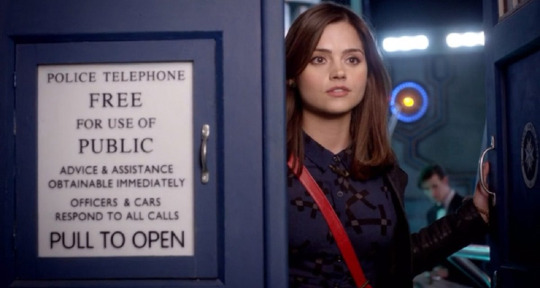
Clara is a whole other can of worms. I could probably dedicate an entire article to her character. I should clarify that my initial dislike for her character is somewhat mired in personal disappointment. By the time Clara was introduced, we had seen a string of modern human companions. We got the occasional tertiary companions from the future, such as Captain Jack or River Song. But we hadn't had a main companion from the past, future, or another planet. So when Jenna Coleman was introduced as Oswin Oswald, Junior Entertainment Manager of the starliner Alaska, I was very excited. Finally, a companion from the future! I was so ready for the Doctor to go on a quest to save Oswin from the cruel fate of becoming a Dalek. What an exciting storyline that was going to be.
And then we see her as governess Clara Oswin Oswald. Ok... Well at least she's still from a different era, right? Oh, she's dead now too? Oh. Much like Moffat's Dracula, all of this great promise was suddenly dashed against the rocks of a contemporary setting. Sigh. I was so excited. What we're given in “The Bells of St. John,” is a new character with less direction than either Oswin or the governess before her. So much that Moffat had taken to literally modulating her brain with an app. Maybe she's really good with computers now? Sorry friends, much like Rose Tyler's gymnastics and Peri Brown's botany, it's never going to come up again.
And this is the biggest issue I have had with Clara Oswald. She spends most of her screen time fluctuating between what character they're writing her as this week. The writers simply didn't know what to do with her while the Doctor tried to figure out why she's so "impossible." One week she's wacky, one week she's stern, another week she's bisexual queer bait. Her characterisation is all over the charts, which sadly, tracks with her entire storyline. She's a woman, fragmented across time, and so is her personality. And don't even get me started on that impossible girl nonsense.
Steven Moffat once said in an interview that one or two people usually guess his big reveal ahead of time, but that no one had guessed Clara's. Perhaps that's because nobody's fan theory was "It's going to be absolute shite." Instead of just being a woman who gets to be her own person, she has to become the most importantest companion. She has to save the Doctor by being planted throughout his timeline, saving him from the Great Intelligence. You know, by sometimes being born as herself, and other times being born as a Time Lord. Sometimes knowing who the Doctor is, other times having no idea whatsoever. Sometimes having a name that is a play on of Oswald, or Oswin, or Clara. And at no times did it make any kind of sense.
The funny thing is, that for me at least, Clara's character doesn't really become interesting until all of that nonsense is behind her. The Clara I find most compelling is the Clara in mourning. Clara post-Danny Pink is a Clara with focus. Her mood swings seem more from a place of destructive behaviour in the wake of great loss. Watching her hold the TARDIS keys hostage above a volcano was some seriously gripping stuff. Aside from the gross digs at her appearance, I found the Twelfth Doctor's relationship with Clara far more endearing than that of the Eleventh Doctor. It may have taken them until her final moments as a companion, but they did get her right, in the end.
3. Melanie Bush
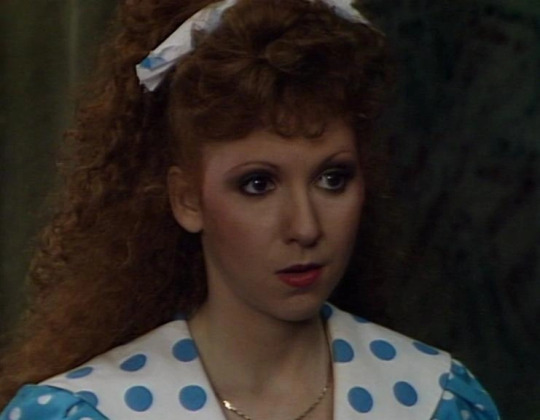
Back in 2015, I had the opportunity to meet Louise Jameson, who played Leela, my all-time favourite Doctor Who companion. I also got to meet Colin Baker, who was all charm. Also in attendance was Bonnie Langford, aka, Doctor Who's Mel. After having gotten autographs from Louise and Colin, and having circled the convention hall a few times, I decided "Sure, why not. Let's meet Bonnie Langford. It's only 10 quid for an autograph." Upon meeting her, she was a very kind woman, and even still, I was racking my brain for something nice to say about Mel. To save face, I lied a very simple lie. I said, "I really liked you in Doctor Who." She smiled, said thank you, and signed my picture. And I walked away, taking my shitty liar mouth with me.
Because the fact is, I didn't like her in Doctor Who. I found every moment she was onscreen excruciating. From her poodle haircuts, to her 80's disaster attire, to her fat-shaming the Sixth Doctor, to her constant screaming at every little thing, she depressed me. I spoke in my review of "Terror of the Vervoids," just how weird it was that we're never actually introduced to her as a character. Instead, Peri is written off, and suddenly, Mel is there, already chummy with the Doctor. You guys know Mel, she's the Doctor's friend, because we told you she was! Instead of getting to know Mel slowly, we're thrown into the deep end, forced to sink or swim within the curls of red hair piled high. Mel doesn't just come out of nowhere, she comes on strong. Fitness expert Mel here to get your fat Doctor Who loving asses into shape. Drink this carrot juice you geek pig!
Not even in Big Finish audios was I finding myself warming up to Mel. When Ace was introduced, they couldn't have pushed Mel out quicker. I found everything about Ace immediately refreshing. Here was a calm and collected badass rebel that I could get behind. It's ironic then; that it was in the Seventh Doctor era that I have begun to find something likeable in Mel. Much like Clara Oswald, a changing of Doctors enriched my appreciation for her character. This appreciation didn't come immediately, mind you, it came about around my third or fourth watch-through of "Paradise Towers."
Perhaps it's the influence of Andrew Cartmel, but with the Seventh Doctor, I have begun to appreciate Mel in the snarkiest manner. Mel is best utilised as a commentary on the Doctor/Companion relationship. She's precocious to a fault, she chews scenery, she screams at the drop of a hat, and she is oftentimes a naive idiot. Yet in "Paradise Towers," it becomes hilarious. Like much of the 80's era of Doctor Who, there is a very "2000 AD," atmosphere to the stories, and I could easily see this as a setting for Judge Dredd to drudge through, busting skulls and filling bodies with bullets. Setting the sunshiny persona of Mel against this backdrop is so brilliant that I can't imagine another companion in this story. Where she would usually grate against me, her sharp contrast from the things happening around her is exactly why I began to soften toward her.
Not even the ire from the Kangs could shake Mel's confidence, which is oddly what makes her cool. Or "ice-hot," as they would say. For the first time, Mel's headstrong sense of self makes her a rebel. She doesn't need to follow a crowd to feel accepted. Sadly, very few writers were able to find this core to Mel, but it was enough for me to be able to look at her in a different light. I could finally look at Mel and say I did like her in Doctor Who. Even if it was just for a moment, and even if it was somewhat at her expense. From a very cynical perspective, Mel can actually be pretty fun.
4. River Song

I know a lot of you are probably aghast to see River Song on this list, but I assure you, I have my reasons, and they are not without consideration. I should begin by saying some good things about River. She's smart, she's competent, she's got a healthy grasp on her sexuality, and she's cool. Why then did I not like her very much the first few times I watched her? Well, if you hadn't noticed, the bulk of this list are characters written by Steven Moffat, and once again, it all comes down to writing.
We're first introduced to River in the Tenth Doctor two-parter "Silence in the Library/Forest of the Dead." At first, she's just one of a team of forgettable space scientists on an expedition. However, as she finds out the Doctor is who he is, her entire demeanour changes. Like Mel on steroids, we're given a heaping dose of "Who does this bitch think she is, being all familiar with the Doctor?" Only, instead of it lasting one episode, it's every interaction we have with her character beyond this point. Instead of getting to watch River and the Doctor grow as a couple, we're forced to watch them meet in opposite directions. It is the antithesis of "show, don't tell." Everything about the Doctor and River's relationship is implied. "You're going to love me someday," she promises. Couldn't we just see it play out naturally? Spoilers.
This idea is one that can only really be done on a show like Doctor Who, where things are wibbly-wobbly, timey-wimey. The problem is, this doesn't mean that the idea is worth exploring, or even successful. It's made even worse when the relationship implied is one deeper than friendship. The Doctor is famously chaste, married only to his TARDIS and what lies ahead. Because of this, the idea of a person the Doctor will someday trust enough to share his real name and eventually marry carries with it a sizeable amount of convincing. Such a huge shift in the show's dynamic requires a lot of character development. Sadly none of that is to be seen onscreen. Who is Jim the Fish? Who cares? Steven Moffat's joke of "I'll explain later," became painfully prophetic of his time as showrunner.
I've got no complaints about River being a Time Lord, or even her being the child of Amy and Rory. Those elements are fine, really. It's the way in which she is presented which I find most detrimental to her character. I never did buy into the idea that the Doctor loved her as a wife. Their wedding seemed necessary to save the universe, as opposed to a union made out of love. Any kind of enjoyment I've ever gotten out of River stems mostly out of my love for Alex Kingston's performance. Where the show fails to establish her, she more than makes up for in style and substance. I grew to like River Song, despite the show's failure to ground her properly. River grew on me as she always said she would, but by no effort on the part of the writers. River is cool because River is cool, not because it was inferred that she was.
5. Susan
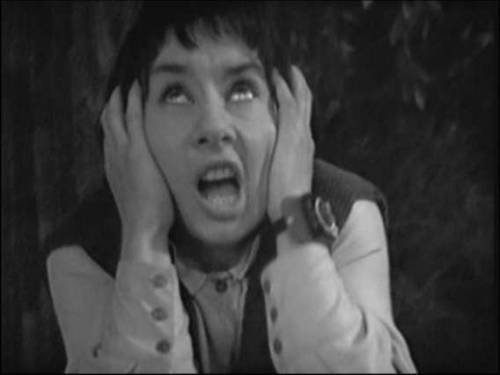
If you’ve followed this blog long enough, you’ll know I’ve already mellowed on Susan. In my reviews of the First Doctor era, I’ve had mostly good things to say about her character. This doesn’t change the fact that I found her utterly irritating at first, and it feels appropriate to talk about it here.
My initial dislike for Susan is a lot like my intial dislike for Clara. A lot of it was wrapped up in my own expectations of the character. Susan is the Doctor’s granddaughter. She is a Time Lord, therefore she should also be brilliant. And we get a lot of that in her first episode. She is mysterious, she’s enigmatic, and she is brilliant. Even her teachers at school found her perplexing. But the show doesn’t continue down that line. In fact, there are times when they make Susan borderline stupid. But how much of this is clouded by my own preconceptions?
For starters, Susan wasn’t a Time Lord. At least, not then. She was just a young girl. She may have been smarter than her fellow students, but this played more into how she was raised. So when the show depicts Susan screaming at every little thing, grabbing her hair dramatically, it smashed apart my mental image of a Time Lord. I couldn’t appreciate that they had her act this way to help sell a bad effect. Oftentimes Susan, like many Doctor Who companions, had her character sacrificed to make the baddies scarier. It was a product of her time, and even still I feel her character suffers for it.
However, one of the things I have discovered through repeat viewings of the First Doctor era is the surprising amount of character development among the TARDIS crew. The Doctor, Ian, Barbara, and Susan all go through deep character development that was sadly often secondary in classic Doctor Who. Before the nature of the Doctor and companions was transient, there was a feeling of a family bond forming. Through this, I have come to find Susan to be a rather deep and sensitive person.
When it comes time to say goodbye to Susan, I can’t say I exactly agreed with the method. The Doctor locking her out and deciding she was mature enough to set out on her own felt hasty. But I would be lying if I didn’t agree that Susan had gone from a little girl to a young woman at that point. When you stop expecting Susan to be the Doctor, and allow her to be a kid, she grows on you instantly.
6. Adric
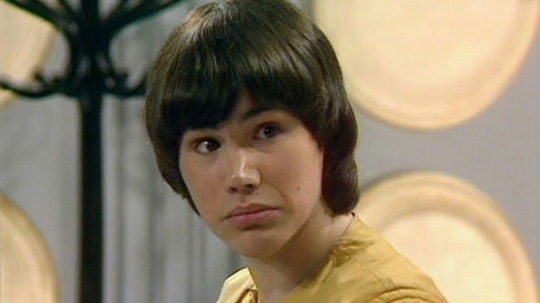
Let's be honest; it's not really original to hate on Adric. It's nothing new to point out what a bad companion he is, but here we are. Something I constantly endeavour to do on this blog is to be fair. One of my biggest complaints about the Doctor Who fandom is the proprietary attitude people take toward the fandom. The "I don't like it; therefore you shouldn't like it," attitude spat with such vitriol is one of the worst parts about being in the Doctor Who fandom. So when you say "Adric is my favourite companion," I'm not devising an argument for how wrong you are, it's fine. Like who you like. This doesn't mean I'm not also thinking in my head "What? Why?" Because I honestly, without malice, do not understand.
The most I ever enjoyed Adric, was in his introductory story "Full Circle." Setting him against a group of fellow Alzarians dilutes his lesser qualities. In fact, when paired with Varsh, he almost seems likeable. Sadly, we have to say goodbye to Varsh, and it's downhill from there. We're forced to watch a contrarian boy genius butt heads with the Doctor while he waddles around in a toddler's outfit while showing off his pound shop sheriffs badge for "mathematical excellence," to anyone who will listen. Adric is so obnoxious that he makes Wesley Crusher seem likeable in contrast.
However, it's not just his contrarian nature that makes me despise Adric, he's also disloyal to the Doctor and his friends. He's so susceptible to bad ideas as long as they a presented logically, that I've dubbed him the Ben Shapiro of the TARDIS. He's a smarmy little shit who believes himself superior to women, and he's really got no justification for his ill-placed self-confidence. Constantly demanding respect while giving very little reason to deserve it, he's like a poster child for incels. To make matters worse, he's oftentimes wrong and easily duped into taking the side of evil, turning him into more of a liability than an asset.
Recently, the idea that the Thirteenth Doctor could save someone from sacrificing themselves by using the TARDIS at the last moment to save them came under fire. "Why didn't the Doctor do this for Adric?" they said, forgetting conveniently when the Twelfth Doctor did the exact same thing in "Into the Dalek." But yes, why indeed? Why would the Doctor ever let a duplicitous, argumentative braggart die by their own stupid need to solve a math problem? My headcanon is that the Doctor got better at flying the TARDIS. The real reason is that people hated his character. The silence over the credits after Adric dies isn't out of respect for the character. The real reason is that the BBC couldn't secure the rights to Kool and the Gang's "Celebrate Good Times," before it aired.
Listen, I am not unsympathetic toward Matthew Waterhouse. He never should have been given such a big role, considering his utter lack of ability at the time. I imagine it was his own insecurity that fuelled his on-set antics. Giving unsolicited advice to veteran actors is cringey, but also the actions of a young and naive boy, in over his head. I know I said I was going to try and treat the performance as secondary, but in this case, it goes hand in hand. He has the stage presence of a fake. Every moment he's onscreen is disingenuous. The fact that he is present at the death of my favourite Doctor, stinking up the scene is genuine pain to me. If he has been made better in Big Finish, I've not yet heard it. As of now, there is nothing I've seen of Adric that has changed my opinion. But I'm glad if he makes you happy.
#Doctor Who#Danny Pink#samuel anderson#clara oswald#jenna coleman#Melanie Bush#Bonnie Langford#River Song#Alex Kingston#Susan#carole ann ford#adric#Matthew Waterhouse#tardis#bbc#companions
11 notes
·
View notes
Text
Analysis of X: Excalibur: The Sword is Drawn
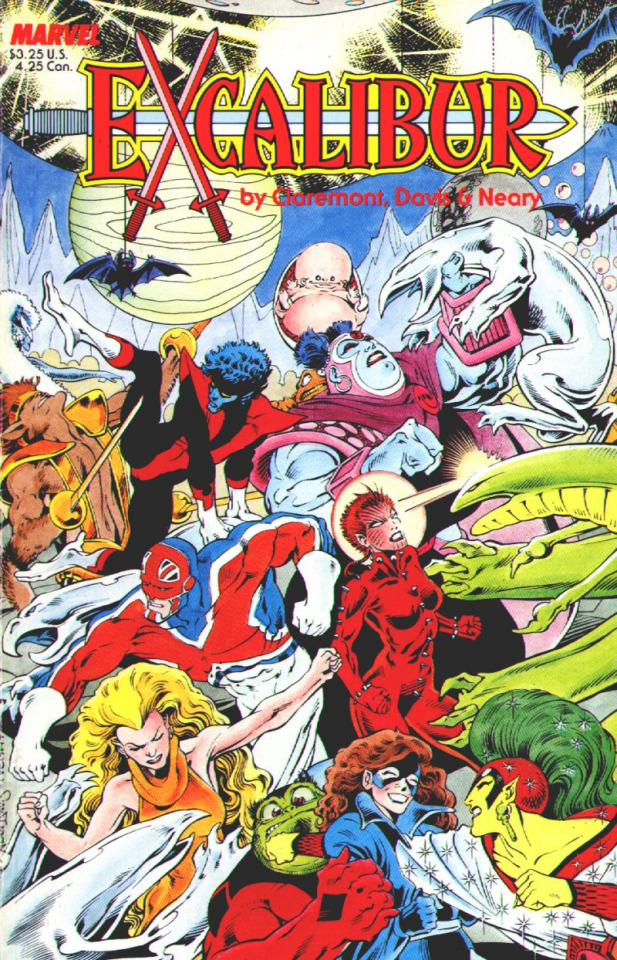
In honor of britan’s premire superhero team returning today, we take a look back at the original team. Kitty Pryde and Nightcrawler must team up with a drunkard magical british superman and his chipper shapeshifting sorta girlfriend to save their old teammate from an alternate dystopian future with the power of a god from both a squad of skin stealing wolves sicced on her by a sinsiter reality show producer from another dimension and a group of intergalactic weirdo bounty hunters after her due to an entirely separate omniversal dictator who wants to bang british superman. Somehow, Grant Morrison didn’t write this. I would like to, if I may, take you on a strange journey after the cut.
Excalibur has always been the odd mutant out of the X-Men franchise.And that’s in part because the bulk of it’s mythos and characters come not from the deep wells of the X-Men comics of the time, but from another character Chris Claremont had a huge hand in: Captain Britain
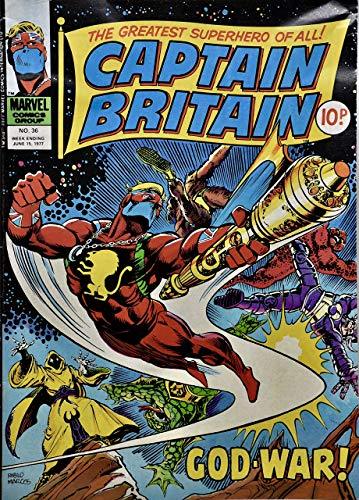
Created shortly after Claremont got his start on the All-New All-Diffrent X-Men, redefining the X-Men forever and making them into the sales juggernaut they were for the 80′s and early to mid-90′s and are again today at long last, Captain Britan was Brian Braddock, a scientist who, while escaping a hired goon who torched his workplace, crashed his motorbike. He was saved by, of all things, Merlin... yes exactly the one your thinking of.... and his daughter and omniveral guardian Roma. They choose Brian to be their champion choosing either the staff of right or the sword of might and, not really being a fighter, Brian chose the staff and a hero was born.
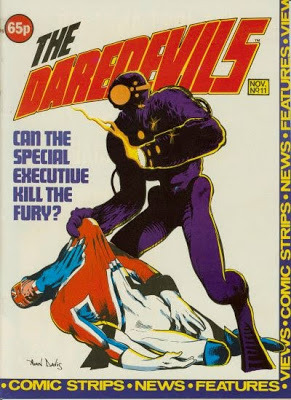
Cap was created for the UK Divison of Marvel and while Claremont did a sizeable amount of work on the character, including introducing Brian’s sister and future X-Man and as of this week Captain Britan herself Betsy Braddock, it was two other men who made most of his mythos and the stuff that would end up being the backbone of Excalibur: Alan Davis, an absolutely monsterous talent of an artist and all around nice guy and... your going to want to sit down if you don’t know this I sure as hell was surprised, Alan Fucking Moore... and if that’s not his actual middle name it should be. Yes he of long beards, genere definting runs and yelling at the young people to get off his lawn and DC to stop hurting his baby Watchmen, THAT Alan Moore worked for marvel breifly. This was his only work with them shockingly. Not so shockingly he and Davis redefined the character, created most of the concepts that would be carried over to Excalibur, and gave the character a spiffy new costume seen above, one so good it’s stuck even into the modern era. Moore, and some other artists in addition to Davis, crafted a long epic about Cap going up against Mad Jim Jaspers, a reality warping mutant who was as insane as his name suggested and introduced many things that would become the backbone of the character, as well as establishing Moore’s habit of taking a less than sucessful B-List hero and utterly turning him on his head. Their also the ones who dubbed Marvel’s main universe 616, a fun fact I honestly had forgotten.
But of course after Moore left Cap fell by the wayside, making a cameo or too in other marvel books in the US while Betsy made her way to the X-Men just when they needed new blood most. More on that in a bit. But he wouldn’t stay on the sidelines for long. See Chris Claremont has a habit of taking characters he created and using them later if they’d been forgotten somehow or put off to the wayside. Mystique, one of the x-men’s most iconic enemies... was a Ms.Marvel (The carol danvers one before she got the rank up), enemy. Sabertooth? An old iron fist villian he’d created and taken a shine to. Arcade was inveted for a team up of Spider-Man and Captain Britan before primarily becoming an X-Men villian for most of his life. And of course Betsy was a a supporting character who became one of the x-men’s most iconic members through a weird mind swap with a japanese woman before recently getting her old body back. Claremont dosen’t like leaving his charcters to twist in the wind and thus brought most of them into the x-men mythos. Even Spider-Woman, depowered at the time, ended up as a major Wolverine supporting character. One of Claremont’s strengths as a writer to me is that he never truly forgot anything he created or worked on, and the X-Men benefited greatly from it.
So while it probably surprised american readers who only thought of Captain Britain as a c-list hero who teamed up with Spider-Man and Captain America, it’s no surprise in hindsight that for his second X-Men ongoing, having also made a TON of mini series, he choose to bring Brian to the big time. While I can’t find much background on Excalibur, I conjecture that Chris wanted to go a bit lighter.
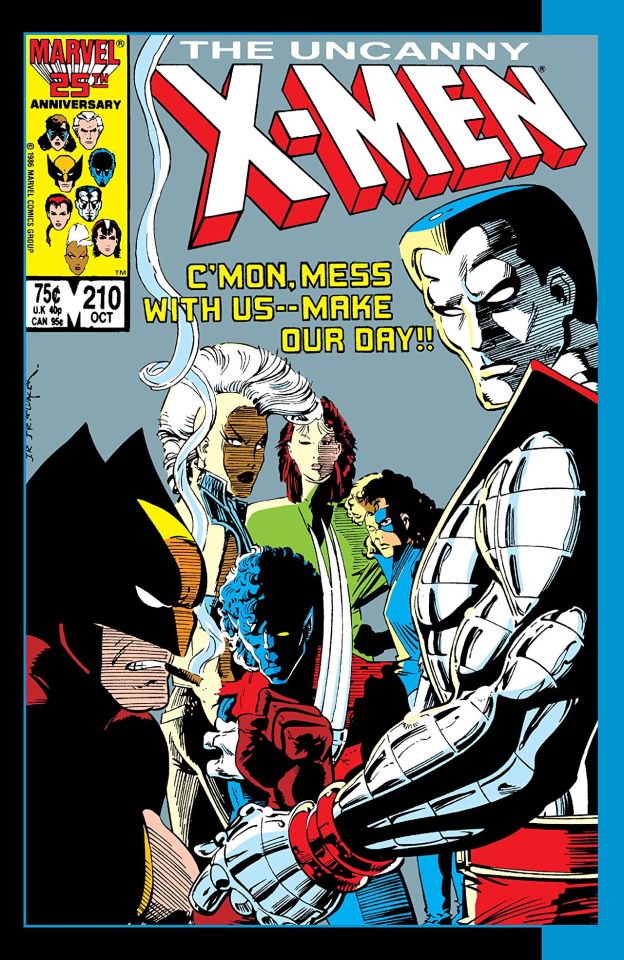
The X-Men were in a DARK place at the time. I mean the X-Men were never all sunshine and roses but most of the humor of the book and lighter moments were gone at the time thanks to the Mutant Massacre, an event where the Morlocks, a group of disfigured homeless mutants who felt at odds with society and thus lived in the tunnels under New York, were slaughtered by professional hitsquad the Mauraders who killed all but a handful of them and during the fight with the X-men took 3 of them out of commission: Nightcrawler had fallen into a coma after overtaking his already crippled teleportation powers defeating one of the mauraders, Kitty Pryde slowly started to disappear, unable to phase back to solid after taking an electric spear for Rouge, and Colossus was heavily wounded in ways I forgot and since he rejoined the X-Men, aren’t really relevant here anyway. The X-Men were up against the wall against a barrage of ruthless opponents, working with longtime foe magneto since Xavier got trapped in space, as you do, and were not in a really happy place. So it feels like, even if the angst was still present because Claremont would go into withdrawl if there wasn’t some form of angst to work off, Excalibur was created as a way for him to do something different in the X-Mold and lighter so he could go as dark as he needed to. So by injuring Kitty and Kurt, he took them off the board and had a starting point for the team, and by adding Captain Britan and his girlfriend Meggan, a shapeshifting empath brought back one of his own creations and brought him into the american side of Marvel, and gave him an almost complete team. It also had the bonus of likely enticing Alan Davis, who in one of the few background things I could find about this book, didn’t really want to work on an established title like X-Men where there were expectations how it was supposed to look etc. But they were still about one member short of a team... but thankfully chris claremont had squared away a spare x-man for just such an occasion.
Enter. Phoenix, aka Rachel Summers. The daughter of Jean Grey and Scott Summers from the Days of Future Past timeline, Rachel ended up in our timeline, bonded to the Phoenix Force like her mom, and struggling with the power, eventually running away after attempting to kill Selene, an evil sorceress who hunted her in an attempt to drain her power. She fled, not sure wether she should rejoin her team or not, and was instead lured into joining Mojo on the promise of a new start. Mojo.. is this guy.
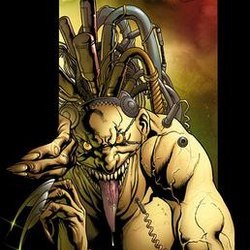
Strap yourselves in for this one: Mojo is the dictator of another dimension that runs off TV, essentially crafting shows for the media hungry populous and kidnapping the X-Men every so often to show up on his programs, to the point he once swapped Psylocke’s natural eyes out with robot camera eyes that looked like the normal eyes so he could record the X-Men’s adventures as it happened, which itself isn’t a bad concept. He didn’t show up to Rachel in person of course, partly because he’s too lazy and partly because he looks like what happens when lightning strikes a pile of twinkies and exposed wiring and somehow brings them to life. She was sent here for the same reason as Kurt and Kitty: to keep her off the board and set up her return here. It’s one of Claremont’s strengths to me: While he ocasionally forgets a subplot or dosen’t realize how wonky one is, more often than not he knows where the story is going and has a plan for it, and thus set up Excalibur a year in advance in the pages of Mutant Massacre.
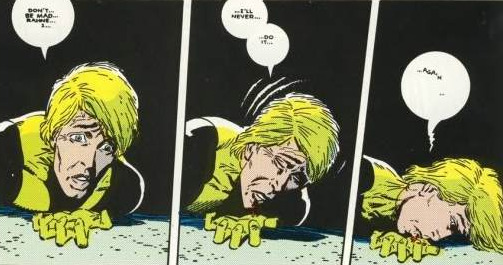
Speaking of setup there’s one final thing to cover before we begin, the second X-Men crossover event and the one that directly leads into this: Fall of The Mutants, aka one of the worst days in the life of one Kitty Pryde. First her best friend and human google translate Doug Ramsey died while on a misson with the new mutants, sacrificing himself to save the life of his girlfriend Wolfsbane.

As if someone was challenging god to make her days worth, at the same time as this tragedy the X-Men, at the time made up of Storm, Wolverine, Psylocke, Rouge, Havok, Dazzler, Longshot and with tag along Madeline Piror whose story is too much to get into here, were locked in a battle with force of chaos and actual demon Nemisis, a being summoned by their sorta ally Forge by accident. Forge can also build any device he pleases but since every fifth x-men character has magic ruin their life, someone had to take the bullet caked with demon blood. At any rate the only way to stop him.. 9 souls were part of the ritual that brought Nemisis in, 9 souls were needed for the ritual to seal him up. And the X-Men, being true heroes determined to do whatever it took, gladly offered up their lives to defeat the demon and save the world. As the world looked on, the X-Men died, for once not feared and hated, but honored and mourned as heroes. Of course this being a comic book Forge’s method of saving the world was turning the X-Men into pure soul energy and throwing them at the demon but that somehow makes it more epic. And of course, it’s no suprise one of their dearest friends was watching from Muir Island, which was serving as a recovery ward for the surviviors of the massacre and was run by longtime X-Men Ally and lynchpin of Hickman’s run Moira Mactaggert

Thankfully, Kitty got one tiny sliver of sunshine on the worst day of her life: Kurt woke up from his coma... just in time to tell him the only family he’d ever known is dead. And that’s where we pick up, with our two heroes trying to figure out what to do now they’ve lost everything. But before we FINALLY get started, this bit was way longer than I meant it to be, your probably curious how long the X-Men stayed dead as well.. this is comics and they were the hottest team int he world. This wasn’t going to stick even if Claremont was serious about ending the series. And the answer, and i’m not making this up I counted, is two pages. Yup, TWO PAGES. Not kidding. Ironically enough Roma, the omniversal goddess daughter of merlin I mentioned, got wrapped up in all this and, moved by the X-Men’s bravery, gave them the chance to come back and start over however they like, and the X-Men choose to be unable to be picked up on tape and let the world think they were dead so they could strike back at their mounting enemies. Granted I feel that while the “play dead and take out our worse foes while we have the advantage” is a good part of it, not telling the new mutants or kitty and kurt is not only cruel, but just paints a target on a bunch of teenagers backs. Sure teenagers who’ve faced worse but still. But I digress, that’s a rant for when I cover Fall of the Mutants at some point and this exposition has taken far longer than I wanted it to. And so here we are at the one shot that would forge a team and finally, we can get into it:
The cover, way up there is decent. It shows a nice right melee between Excalibur, the Warwolves and the Technet, though it makes it look like Gatecrasher is part of the team when she is in fact one of the issue’s main antagonist and is overall a bit weirdly composed. It doesn't help the proper Excalibur #1 has one of the best x-team covers of all time.
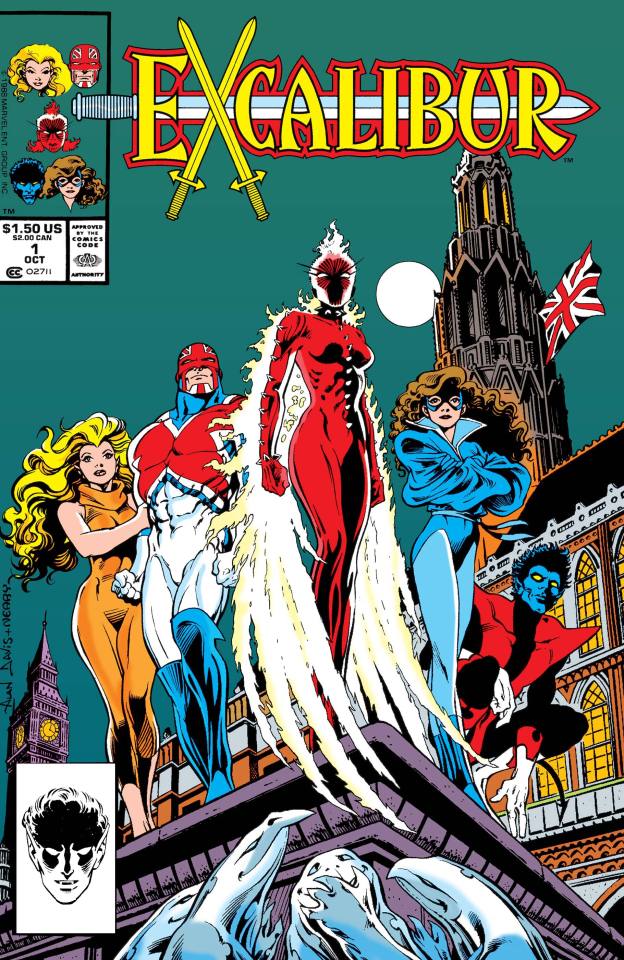
As you can see the comparison dosen’t help the far messier above cover. It’s just average in comparison to the creative and funny covers Davis would provide throughout both runs and the majestic one above.
WE open on Kitty Pryde, understandably, having a nightmare, being dragged by a crew of makeup people just off screen and smack into
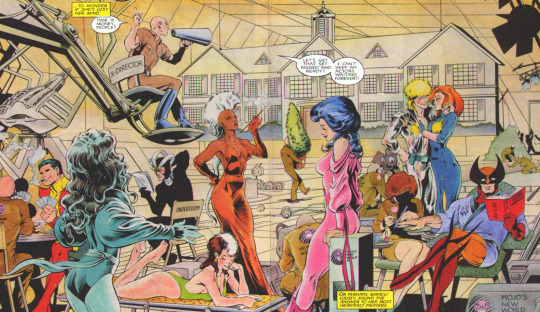
Oh good marvel’s already working on the new X-Men movie. Thank god I thought they really WERE going to take 5 years to do it. Naturally she is curious why their in hollywood but dosen’t suspect fowl play because well... to put it in a personal persepctive if I saw my grandpa I lost a few years ago or my dog I lost in high school that was the same age as me, alive healthy and back, i’d be confused as hell but mostly? I’d just be relived and hope beyond hope it was real, as poor Kitty is diong. Unfortunatley the illusion something isn’t up lasts all about a panel before this happens.

First of all: AHHHHHHHHHHHHHHHHHHHHHHHHHHHHHHH!. Second. as AHHHHHH! as it is.. it could’ve been worse.

It soon becomes clear something is up as Kitty wails around confused, wondering why Rouge’s powers don’t work and why the X-Men are acting as if nothing is real before action is called and they run off.. it’s then Kitty finally encounters a freindly face.
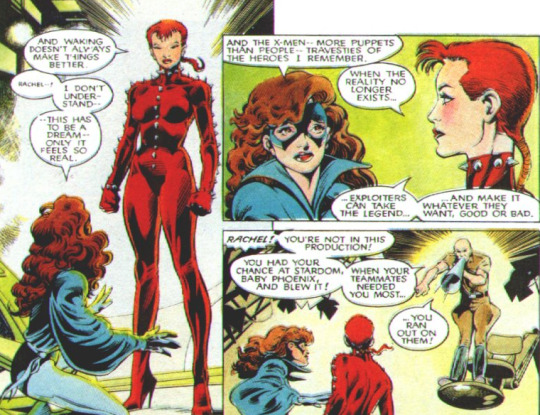
It's now from context clear just what the fuck is going on: this isn't JUST a dream: Rachel has somehow dragged Kitty into Mojoworld through her dreams, warning her, as seen above that with the X-Men gone, their image can be twisted and exploited by those wanting to use it for their own image. This warning is cut short when Fake Xavier starts shouting and soon we get this lovely image.

As we can see Rachel deeply regrets running but Mojo won't let her go.. fortunatley Kitty phases the chains and lets Rachel go, with Rachel promising to see kitty again soon as she flees.. unfortunatley Kitty's pissed off Mojo's actors...

Again, it could’ve been worse.
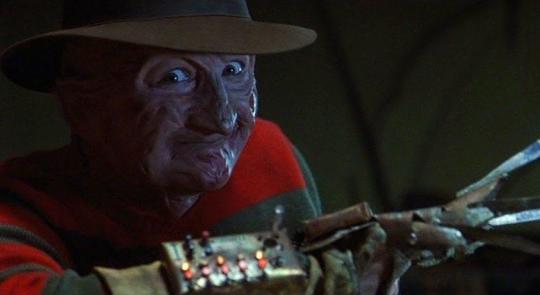
Kitty wakes up and naturally angsts a bit over that fucked up dream she had and then sees a phoenix in the sky, wondering what could it mean and what could the dream mean.

A lot to unpack here. First off... Perverso...
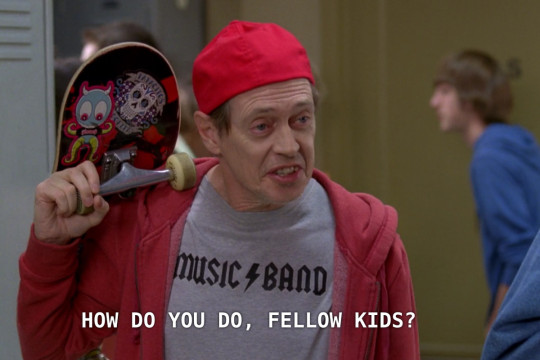
Second, my heart breaks at that last line.. and it’s true. Kitty likely feels, like a lot of people going through grief, that maybe they could’ve done something. Maybe if she was there she could’ve stopped their deaths and saved the day or failing that, she could’ve gone with them. So she wouldn’t have to feel awful about being here while they aren’t, so she wouldn’t feel the unbearable weight of being one of the last X-Men. But the sad truth is, she wouldn’t of made any diffrence. None of them would’ve taken the last slot and would’ve given it instead to their tagalong Madeline Prior so she could see her family again. They died selfilesly, and nothing she could’ve done would’ve stopped them.

As seen above Kitty tries to take solace in petting her dragon Lockheed. Yes Kitty has a dragon for those who didn’t know about him or were only familiar with her from the cartoons.. though why X-Men Evolution never thought to introduce Lockheed is beyond me. He’s a space dragon that stowed away when the X-Men returned from well.. space, and saved Kitty’s life, taking up residence as her pet. He was later revealed to be far more sapient than he seems, but still hangs around Kitty because it’s an effed up world, but it’s a two player game.
But as demonstrated Kitty’s powers have inverted. While she has gotten better, as I talked about in my Mauraders #1 review she was fading from existance shortly after the massacre, her intangiable state is now her natural one. She has to concenrate to turn solid. So in addition to having lost just about everything, her powers are broken too. Kitty then sees a picture of her shortly after she joined the X-Men before having a good cry about how most of the people in the picture are dead and professor xavier got shot up into space. Thankfully he dosen’t have to watch cheesy movies.. unless it’s Cho’d turn to pick the movie. For some reason it’s ALWAYS Cool as Ice. no one knows why.

Meanwhile, in the seas of mood whiplash, we meet Meggan. Meggan, like most of the cast, is a mutant, something I was unaware of until now even though the I just thought she was some sort of magical creature, but no, she’s a mutant and the naration outright calls her one. I’m just stupid or thought they just classifed her wrong I guess. Unlike most mutants, who manifest powers at puberty, she manifested hers at birth. Megan is an empathic shapeshifter, basically meaning that she shifts based on those around her’s perception of her. And sadly her upbringing was not a happy one as, since she was born with fur, her parents saw her as a monster and left her in a caravan alone, with the rest of her romani community making up rumors about her.. and due to being unable to control her powers shape shifted into the monster they thought she was. She was raised on televisoin and thus has a rather naive sense of the outside world, and later bonded with brian after he took her in, her home having been destroyed due to lots of stuff I don’t have time to go into, and she later took up her current default form after realizing she was a shapeshifter in the first place.
But yes our bubbly shapeshifter is swimming with the dolphins and due to her emphatic ablites, she can commuincate with them learns how to swim like them and, thanks to her ablities, has shifted to do so the best. She’s lost track of time though and heads home to the lighthouse she and Brian live in. She returns home to find the place ransacked, and since she didn’t feed her mogwii after midnight.. this time, she searches for the cause.. and the cause turns out to be similar to the reason Kitty is crying her eyes out miles away in scotland.

When Kitty and Kurt lost their surrogate family, Brian lost his too. As stated far above Betsy was his sister, and they were very close from the looks of it, and the loss of her naturally shattered the man. Meggan tries to comfort him but.. it goes about as well as you’d expect, especially since Brian has been heavily drinking on top of his grief.
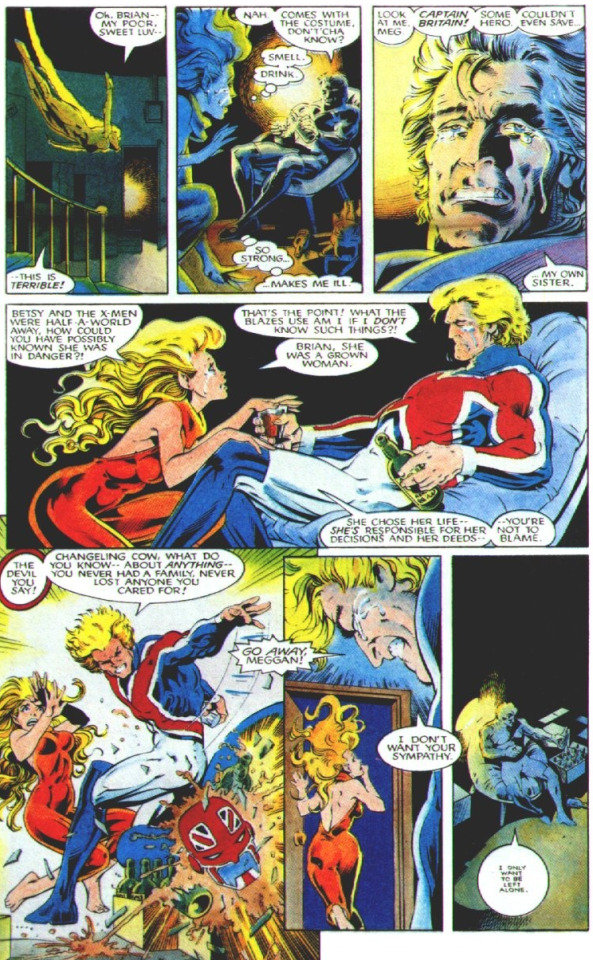
This scene.. is really damn sad but really well written. Brian, as I joked in the teaser, has the powers of superman basically minus the add ons like heat vision and frost breath.. yet he couldn't save Betsy. But as Meggan accuratley puts things, he couldn’t of known she was in danger and she was a grown woman. As I said, she choose to sacrifice herself, and as I didn’t fill in, the spell only works with WILLING participants. All that would’ve changed had he gone is Madelyne Prior would be alive and not him. And it’s things like this that also made me take such umbrage with the X-Men faking their deaths: their causing, real genuine greif to people... while I joked mildly about the telpathy thing, i’m not sure betsy’s range, I AM sure that being a telepath one of the simpliest trick is masking your presence. It’d take a lot of effort and be mildly invasive, but keeping yourself hidden to tell your brother goodbye is hardly more morally grey than faking your death and leaving him in a drunken stupor. This is especailly bad once they get a teleporter shortly into their australian stay, as Gateway could SEND HER to him, with no risk of detection, and have her explain it in person with storm in tow. Instead they hurt their friends and loved ones for a plan that ultimatley didn’t quite pan out.

Meggan herself mopes for a second, understandable as Betsy was her friend too and she's hurt she's gone and blames herself.. before snapping out of it, realizing that Brian is just lashing out and needs help, but unable to face him like he is, she leaves him a pictoral note, since she's functionally illiterate, and goes to get advice from Kitty and Kurt, wanting to help him open up the way he helped her do the same. Meanwhile...
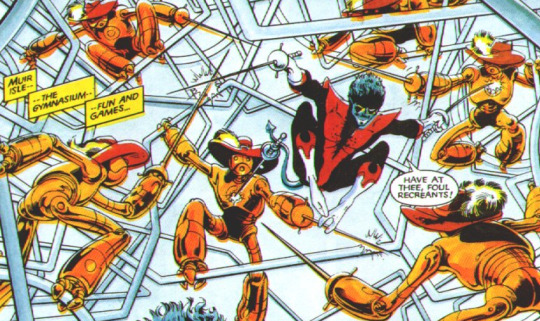
Jesus christ this comic loves abrupt tonal shifts.. but yeah Kurt is excercising, but then reflexively teleports after he takes a hit. As I mentioned earlier Kurt’s teleporting is strained, having gotten injured in a battle with Nimrod, who really hickman you couldn’t of come up with either a better name or a reason he’s called that when you brought him back in House and Powers?, and as a result comaed himself defeating one of the mauraders. And while the coma thing cleared up nicely his powers are still a fraction of what they once were and one teleport while injured no less leaves him too shaky to continue and reaching for the saftey panel. Thankfully Kitty phases through it while checking up on him, having been told through the island’s backup alarms that he was doing this borderline suicidal shenanigan. Kitty naturally lays into him over it.
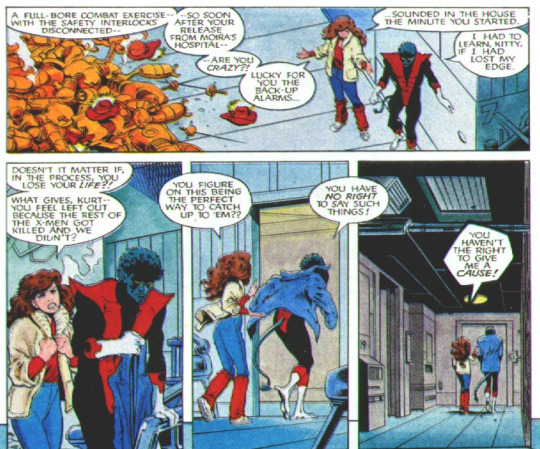
Kitty's rage is entirely warranted: She just lost her surrogate family and her best friend. Things with her parents are strained. She dosen't want to loose the only family she really has left because he feels the same things she feels and is nearly killing himself to try and deal with it. Kurt apologizes, admitting the painful part of it: that he was HAPPY when he woke up from his coma, overjoyed to finally be alive again, to live again.. only to find out his family is dead from one of his closest friends. And with this i'm reminded of Steven Universe.. just go with me. There Pearl mourned for a good decade about loosing Rose because well.. she was everything she had. She , literally and metaphorically, freed her, she was her world.. and Rose moved on to someone else romantically and then decided to up and leave the mortal coil. Her entire world left her and she had no idea to cope or as she put it in song, "Who am I now in this world without her?" That's what our heroes are dealing with: for Kitty and Kurt the X-Men were their world.. not in such a co-dependent way as rose but for Kurt, it was his family: through them he went from a monster in the world's eyes, hiding from it and tired of having to do so, to a bold hero who refused to hide who he was anymore and who had family and a purpose. For young Kitty, she found parental figures in a time when her actual parents, particularly her dad, were going through a messy divorce, found strength she never knew to the point she EARNED her right to stay on the X-Men after Xavier started a junior class and wanted her to go there, and really came of age. The X-Men made them who they are today and without them.. just who are they? But before they can dive into that themselves our heroes find out something disturbing: they had the same exact dream about rachel, complete with helping her escape. Maybe they really did or maybe it was just a warning, the conculsion our heroes reach, and while Kitty does resolve to do something about it, determining that just because their injured dosen’t mean they’ve stopped being X-Men, but before they can deal with this they get a guest.

No but she’s just as weird and abrubt:
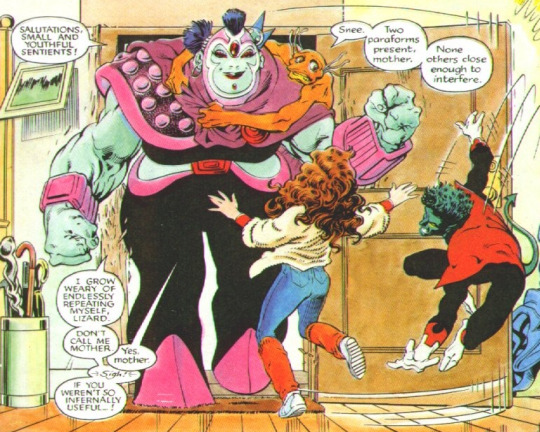
This is Gatecrasher, leader of the The Technet, a group of interdimensional mercenaries and bounty hunters. She wants to speak with the lady of the house but that’s not really and option as she’s kinda on a schedule. You know people to grab, drinks to be drunks, sapient racoons to bone.. that sorta thing.. and the last one isn’t something I pulled out of nowhere the recent Rocket Racoon solo not only brought in the technet but had her fancy the guy. Guess it’s the fuzzy, as Kurt himself will tell you chicks dig the fuzzy. It’s why he’s Krakoa’s orgy meister. Before Kitty and Kurt can find out who Gatecrasher is and why she’s here, Meggan soars in.. and hisses at Gatecrasher. See The good captain and the Technet have a history: they’ve been both enemies and reluctant allies, so naturally Meggan is worried their here for Brian. But this time they have no buisness with the good Captain... and when asked by kitty why she’s here Gatecrasher uses a telecom crystal, some sort of magic hologram recording, to explain herself:

Saturnyne is , as she says an omniversal majestrix. This basically means she runs the day to day operations of the Captain Britan Corps, basically the Captain Britians for every reality, helps give underdeveloped words nudges toward advancment and general multiversal maintince stuff. Sorta like a combination of Omnitraxus and Hekapoo from star vs the forces of evil but without being a racist asshole. I mean she’s still an asshole, just not a racist one. She and Brian have a romantic history. As you can also see each of the team is having a different reaction to her: Kurt is popping a boner just off screen, maybe he can invite her to Krakoa orgy night hmm?, Meggan is pissed because she and Brian were a thing once, and Kitty just found out she likes ladies AND she likes guy. What i’m saying is it dosen’t take an intellectual to get that she’s bisexual. And yes I know she turned down Karma off screen later on but that was A) the result of another writer changing things after the previous writer on both character, Chris Claremont himself, apparently had sizeable ship tease for them. and B) if her ex boyfriend iceman can be retconned to have been a heavily closeted until very recently gay man this whole time, Kitty can also have been sticking to the closet or just simply have not explored that side if we want. Anyways it turns out there here for rachel at Saturnyne’s orders, because she’s apparently a theat to the multiverse.. not too much of a stretch when in one reality her mom going dark phoenix destroyed damn near everything and even here the phoenix force has snuffed out entire galaxies. She’s apparently on her way back to earth, and it’s the Technet’s job to catch her. As for the specifics.. Gatecrasher has no idea. And frankly when an omniversal goddess asks you go fetch someone for what I assume is a yak that has a comparentment in it’s back with millions of dollars stashed inside, you don’t really care. Kitty being Kitty, refuses to help her find their friend and until she knows more, she’s willing to fight her on it. Unfortunatley, as you can probably tell, Gatecrasher wasn’t dumb enough to go after a being that can eat an entire solar system alone.
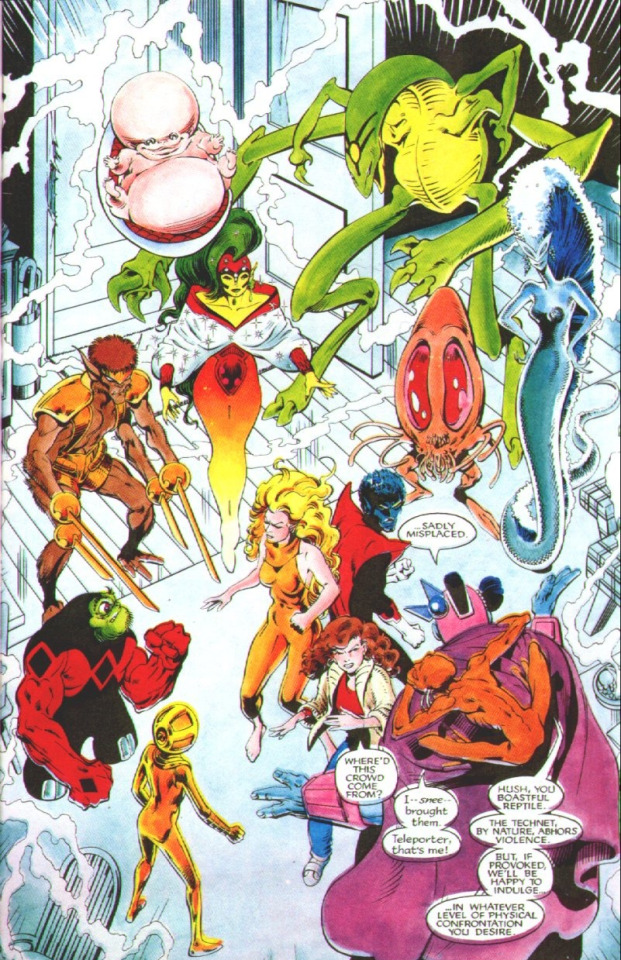
It's here we meet the Technet proper and a fight between two former teammates, a shapeshifter they only just now met and who only Kurt recognized, and a team of weird as shit but highly trained bounty hunters goes about as well as the classic matchup of Wolverine vs "Anyone trying to get between him and his beer stash". Kitty is quickly taken out by the yellow girl with green hair, scatterbrain, whose power is.. just that: anyone she touches has their brain go all spacey and weird and kitty knocks herself out falling over when Scatter shuts her thinky parts off. And as for Meggan..

This is Bodybag. And his power is exactly what it looks like: he gulps people up and then keeps them in his sack on the back. It’s weird but i’ts my kind of creative weird and it makes sense for a team of bounty hunters to have a member to store their quarrry. Kurt wisely BAMF’s the fuck out of there, but Gatecrasher decides not to persue him: He’s not their target, and if he wants his friends he’ll have to come back for them anyway, so it’s not like chasing him all over is really worth the effort. She does have Bodybag snag kitty though, and plans to use her and Meggan as bargaining chips.
Meanwhile Rachel finally returns to the story, as seen above a bit discombobulated given you know, she just crossed dimensions or whatever hapepned. She then ends up at a charity masqurade party , just poofying out of nowhere and when she tries to you know, leave...
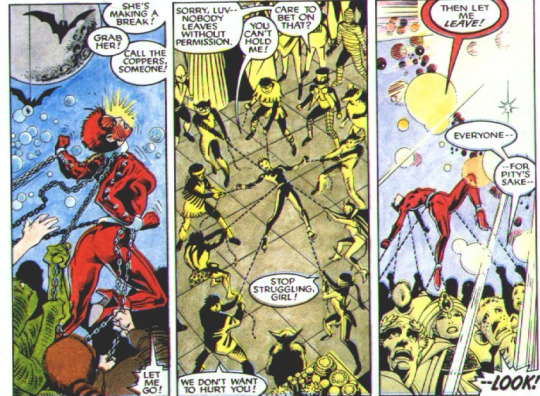
I just... what the fuck kind of charity event IS this? The chains she brought with her but “no one leaves without permisson. “ I just... THIS IS A CHARITY BALL NOT VIETNAM. And who, besides racist assholes, thinks holdiing someone down with chains is a good idea. Just WHAT IS THIS SCENE. Thankfully we get some other party crashers.
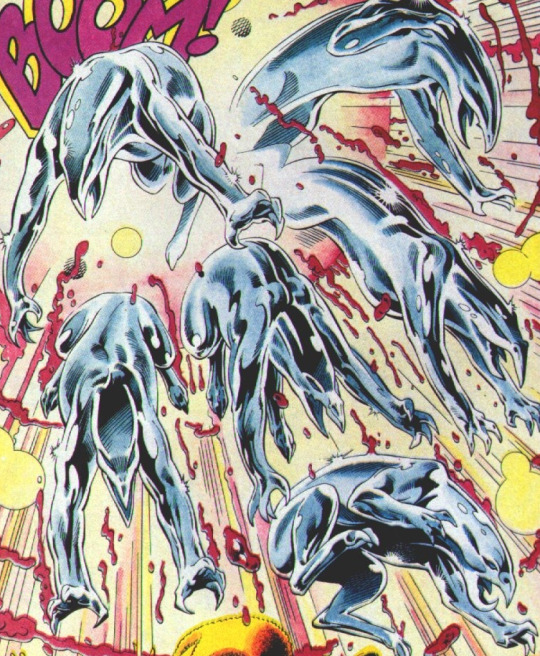
These are Warwolves, a new, as far as I can tell, creation and basically Mojo’s literal hunting dogs. Rachel tries fighting them off but naturally, their Psi-Proof so just blasting them with telekenisis won’t work and uses the objects around her, including her own chains to duck them. But she mutters what’s the point it’s just another sound stage.. except as I said, it isn’t. She’s in foggy london town.
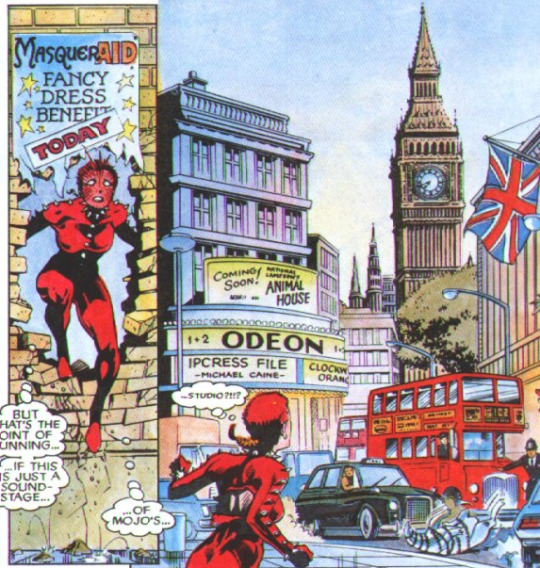
Rachel continues her run through the urban jungle eventually ending up in a subway. No not the restraunt, she’s not that unlucky. Duckign onto a train one of the warwolves globs on.
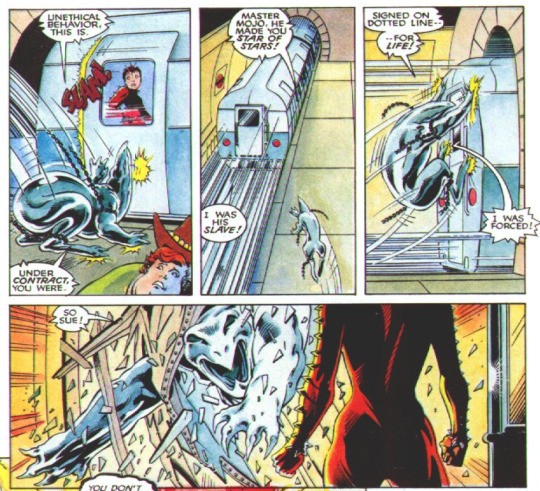
To be fair most hollywood contracts are basically slavery, but Rachel as a point.. she was basically tricked into singing it, again not exactly uncommon, and refuses to take this bullshit.
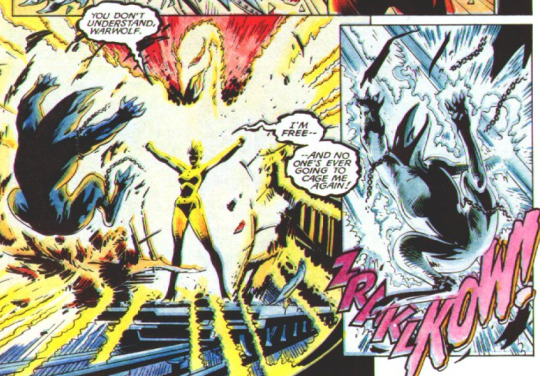
This bit is awesome, and doubly so as I left out a bit of Rachel's backstory on purpose earlier: she was a hound. Basically it meant she was enslaved and conditioned to hunt down other mutants, only escaping shortly before days of future past happened and then escsaping into the present. So naturally the thought of being enslaved and forced to do some asshole's bidding again, to loose her free will? She'll die before that happens and slaughters the warwolf to prove it.. though also scares her fellow passangers in the process. While Rachel tries to explain thing the warwolves greeve.. and Teleporter, Gatecrasher's lizard thing, has located Rachel.
Meanwhile Madison is grappling with the fact that not every issue can be settled by comittee...
Meanwhile Kurt arrives at the Lighthouse to find Brian stinking of booze and asleep, so he decides to do the only logical thing he can think of.
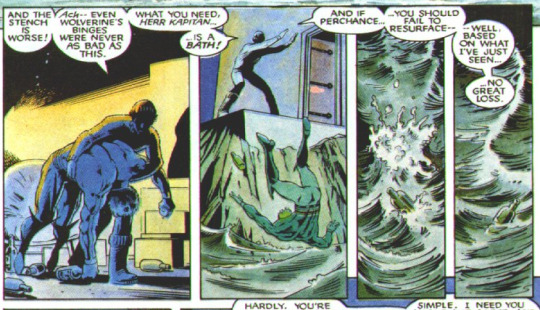
I fucking love you Kurt. So since Godzilla is too busy at his tax audit to save him from the depths of the ocean Brian wakes up himself pissed and assuming someone tried to kill him. Which granted Kurt outright admitted he might drown but given the only two friends he has left in the world and an innocent he just met who fought beside him despite having no reason to besides it being the right thing are in mortal peril, he has no time to play nice. Kurt’s responses to Brian’s outrage are fucking amazing.
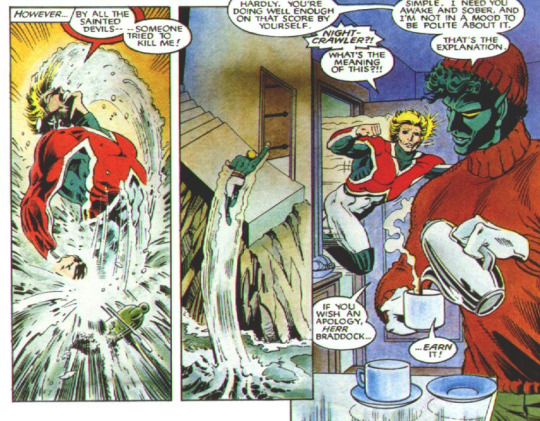
Fucking brutal and accurate: Brian’s alcoholism is killing him and is just as borderline suicidal as Kurt’s play session with largely the same intention. Kurt has no time for wallowing in self pity, no time to baby Brian, as much as it might be warranted, through his grief. Kurt Wagner needs a hero, and since the avengers and fantastic four would likely take hours he dosen’t have, Brian is his best bet at saving his friends. He has no time for pity or sadness, he only has time to save what he has left. He explains the situation to Brian as well as how the hell he found him: since he at least knew of Brian, likely due to Betsy as she was staying with the X-Men prior to joining and just before the massacre, he dug up the X-Men’s file on him and spent the rest of his time getting to him. Brian is, unsurprisingly, in no real mood to help and mopes that there’s really no point in it… and that’s when Kurt somehow gets even more pissed off and 20 times as awesome, with a speech worthy of Sir Patrick Stewart himself.

And as I’ve made abundantly clear that’s the point of this story: The X-Men’s temporary death was unfair, left a lot of pain in their wake and left our heroes scrambling to figure out where do they go from here? And it’s here Nightcrawler is the first besides Meggan, whose simple world view means it was a lot easier to process things and took her three panels to get herself in gear to help Brian, to really turn a corner on his grief. He’s sad his friends are dead, he wishes more than anything that he could’ve died a hero like them instead of living with the misery and sorrow of them being gone.. but he’s alive. And he’s going to honor them the best he can by being the kind of man they wanted him to be. And to me this is why Kurt became leader: out of the five he has the most experience, with only Brian rivaling him in that, but also the most drive. He may of lost everything, but by god he’s going to keep moving. Sure his friends died, it’s the risk of the trade.. but they’d want him to live, to take up the sword and keep fighting so that the dream dosen’t fade out. It’s why, as much as I don’t agree with it, they kept hteir resurrection a secret: because the safety of all mutants, of their friends, is more important than one man. And Kurt is going to honor that. But not before giving Brian another verbal bitchslapping.
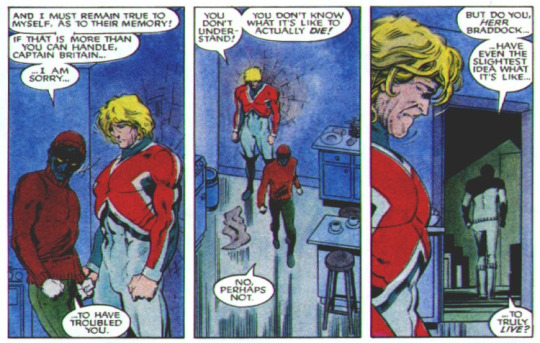
Of course it’s not easy as Brian DID die to become captain britan.. and the memory haunts him. And he wonders when it’ll come from him.. and he’s afraid of it. But the question is will he let his fear of the reaper swallow him whole or live like Kurt, fighting on anyways. To truly live.
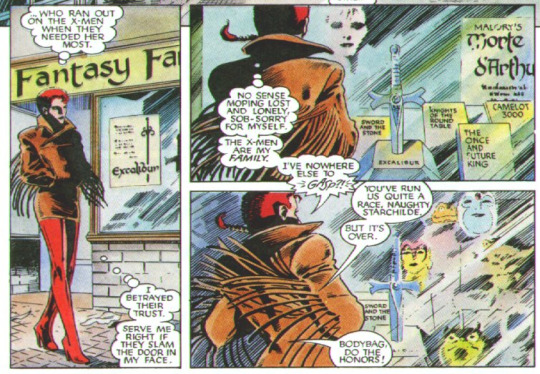
Meanwhile Rachel is the only member of the forming team to not have had a full on mope sesh so she gets on that, but it only lasts for about a panel and like most of the angst in this comic is warranted: Rachel comptemplates if she should go back to the X-Men.. but realizes despite running out on them , their family, and she has no other options. But before she can learn the truth the technet are upon her and bodybag scoops her up. Gatecrasher plans to release Kitty and Meggan and one thing I like that I hadn’t noticed in previous reads is Gatecrasher is a fairly intresting antagonist. She’s not “evil”, she’s just a merc wanting a payday, and in this case was hired by a legitmate if pompus source. While she takes Kitty and Meggan, it’s more out of pragmatisim and as noted she plans to release the two when she could’ve let Bodybag digest them, and when first showing up is perfectly cordial to Kurt and Kitty, and only fights when it’s clear our heroes won’t let her just walk off with their old friend. It makes me glad there’s far more of her and the technet to come as the series goes on and a ton more in Alan Davis run when I get to that. Their intresting characters with unique power sets and inject a sense of fun into what would otherwise be a fairly dreary story.
Anyways before she can do that the warwolves strike and are too dumb to know when to quit so a fight breaks out and Gatecrasher beats the piss out of one while Kurt arrives, watching from the shadows. As for why no one’s spotted him... i’ts simple: One of his powers is to blend into shadows. It’s not used often and it’s forgotten quite a bit, but it is one he’s used on ocasion and even IF Claremont just retconned it out, his foes are too busy to notice. Kurt once again shows how awesome he is and tricks one of the wolves into slashing the bags containing his friends open. Gross but oh so triumphant.
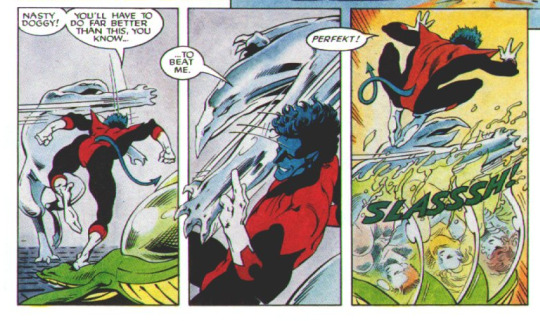
Unfortunatley his victory is short lived: Meggan and Kitty are still woozy as, while I didn’t mention this earlier, Bodybags bags contain a paralyzing goop so they still aren’t quite ready to fight and while Rachel is, she can’t psy zap the dog. Luckily for Kurt gatecrasher yanks it away. Unluckily, she prepares to beat him into furry blue chunklets on the ground. Luckily...
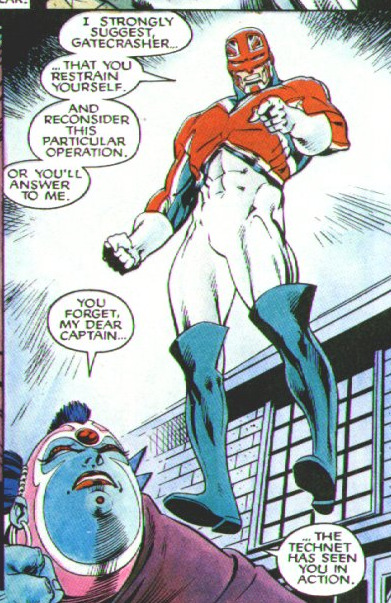
Brian has finally gotten his shit together to save the day.. for all of a panel…

While Brian is fighting who or whatever that is Rachel and Kitty try to get into things but are blindsided by ringtoss and joyboy whose powers well...
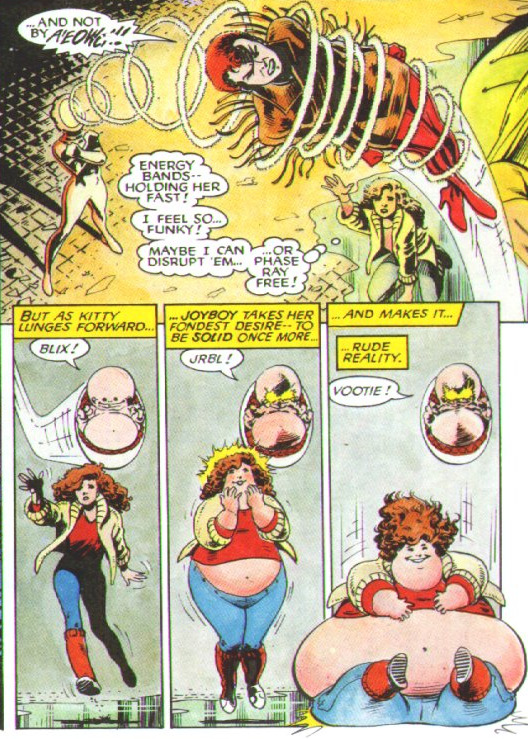
Yeah while ringtoss, if still weird isn’t TOO out of the ordinary for Marvel, Joyboy seems like he’s some sorta lost Jojo’s bizarre adventure stand. It’s also another reason to love the technet as again, their powers are just so fucking creative and weird. But that’s also what makes them such a threat: Their powers aren’t what most heroes usually deal with, and thus they have the element of surprise, helped by the fact their all from separate dimensions, meaning even in space, where their likely more ready for nonsense, they still have the upper hand by being races most space peeps aren’t ready for. Speaking of not ready,w ehave two last members to cover...

They speak for themselves, and while they do so Brian tries to rescue Meggan but is stopped by scatterbrain. Nightcrawler notices their asses are getting kicked and figures out WHY: The Warwolves and The Technet are teams. They work together regularly. Excalibur at this point is three former teammates in a disorienting situation and two british persons they just met. And if they don’t’ start working together they aren’t going to last. So Nightcrawler decides to fix that by knocking a warwolf into Ringtoss, who then collapses into waxwork whose touch takes out both and leaves Rachel free. Rachel quickly takes out Joyboy and with him out of the way, Kitty and Kurt can focus on Gatecrasher:
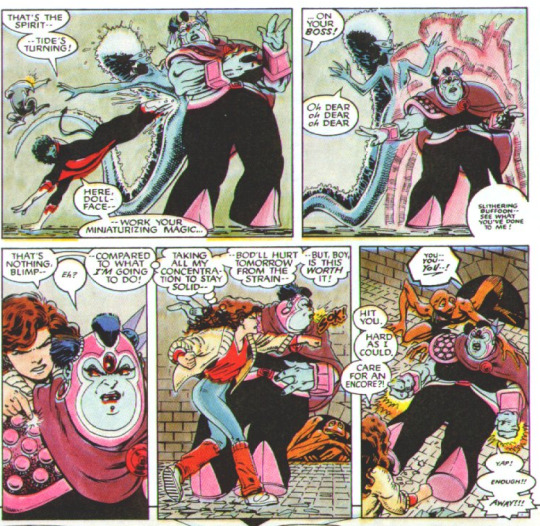
And with that Gatecrasher knows when to fold em and teleports the team away to fight another day, while the Warwolves slinked off in the confusion. Both will be back, obviously, but for now our heroes have one, Brian and Meggan make up and make out, and with the chaos settled Kitty, Rachel and Kurt have a tearful reunion.
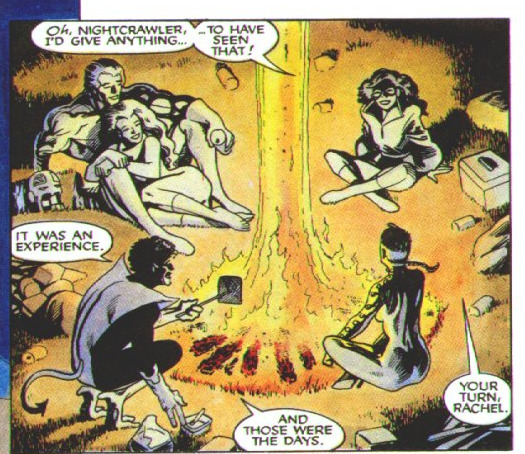
Our heroes celebrate with a campfire and memories of their fallen comrades, with Rachel admitting she’s not sure what’s real or not after her experiences with Mojo. Brian prepares to leave and take care of the Warwolves himself.. but Rachel objects. The three others don’t have lives to return to, and just because the X-Men are gone dosent’ mean Xaviers dream should die out, likening them to the symbol of King Arthurs sword Excalibur. Kitty and Kurt start to agree, pointing out their dream taught them that if theirs a vacuum left in the X-Men’s legacy, someone will use it for their own ends. Rachel affirms her reasons for staying as a team, saying she’s tired of running: She’s done so all her live and she wants to , for once, stand for something. Meggan, having had similar problems in the past, agrees with her and the rest of the crew quickly come on board and thus we close on this image as a new team, and a new legacy, is forged: Excalibur is born.
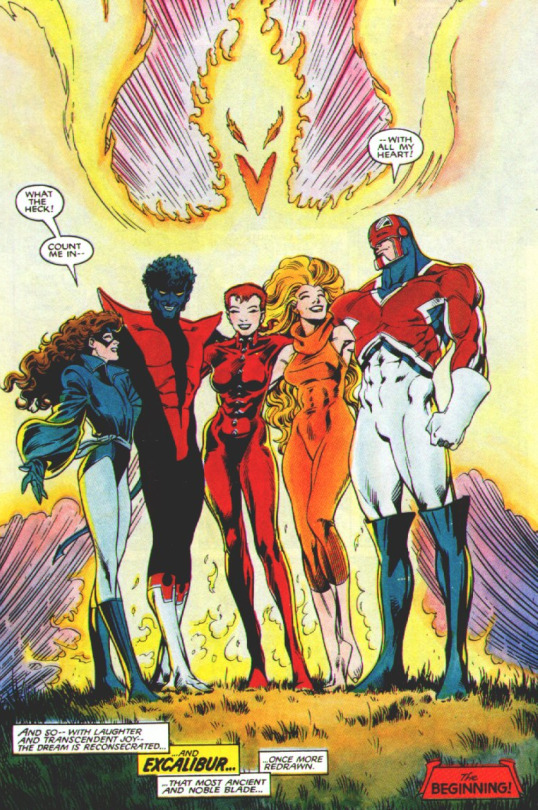
Final Thoughts: The Sword is Forged is an utter classic and a great way to start things off. Our heroes are established, Rachel, who I felt was a bit thrown around by the plot during her time on the X-Men, is fleshed out a bit more and given purpose while Brian and Meggan are decently introduced to the audience. My only real complaints is that Davis and Claremont sometimes forget that American audiences won’t know who half these people are and while they introduce the Technet and Saturnyne well enough, they still never backtrack to explain them better later and what history I DID get I had to dig up for myself online. That aside the story, while having a lot of angst, is well done and has a good flow to it and ends on a high note, the characters are likeable enough, the villains are all creative though the Warwolves feel slight next to the Technet and will get fleshed out a bit more in the series proper. And of course I’d be a moron if I didn’t compliment Alan Davis wonderful art, which captures the whimsical tone well, the emotion in certain scenes perfectly and holds up beautifully years later. Overall The Sword is Forged is a great team origin story and if you liked what you saw here I’d recommend checking it out. Next time, hopefully tonight, we finally get to to the new Excalibur as Brian and his sister and thrust into the shit and a new Captain Britain is born. Until then, courage.
#analysis of x#excalibur#captain britan#meggan#nightcrawler#kitty pryde#rachel summers#the technet#gatecrasher#warwolves#mojoworld#x-men#chris claremont#alan davis#dawn of x
28 notes
·
View notes
Text
Holding Court In A Crown {Roger Taylor}
Sequel to And All The Queen’s Men {Roger Taylor}
A/N: 3630 words. Giselle is fun to write and I love her. Another article style, based off of many conversations between @ginghampearlsnsweettea and I. Let me know what you think.
[And All The Queen’s Men ‘verse masterpost]
HOLDING COURT IN A CROWN - GISELLE TAYLOR in conversation with Vogue UK about her fashion evolution through the decades. (Published June, 1991)
When stepping into the Taylor home, it becomes immediately apparent that this is a home in which public image has always been very important. Gold and Platinum albums alike line the front foyer, shining reminders of the achievements of both artists who reside here. It’s surprisingly modern, hardwood floors and large windows that allow light to stream in, though the house itself is smaller than one might expect. Giselle herself greets me in the front hall, looking carefully casual in a flattering, warm yellow summer dress, that hits just above her knees, and a pair of matching yellow slip on shoes.
I’m lead through the house, past closed doors, one of which I’m told is a personal recording studio, into a open-planned kitchen-dining area. It’s a strange marriage of two aesthetics, no pun intended, the German-inspired open planned living with the dark counters, appliances, and features that make the space feel a little smaller, though it comes together to make something modern and chic, and perfectly suited to both Giselle and her husband’s images.
“Roger’s with the girls,” she tells me, referring to her daughters, pouring us both a glass of water in some of the fanciest crystal glasses I’ve ever seen, “not that he wouldn’t jump at the chance to talk about his “fashion choices”,” her air quotes, not mine, “but I thought I’d spare you the half hour argument about the wine stain, and all the other, sundry fashion choices of mine that he likes to take credit for.”
Giselle herself admits that she’s always been very fortunate in terms of fashion, “I mean, I look good in everything,” though there’s an air of self deprecation about it, “Actually, I’ve had a certain liberty with my work attire that not a lot of people have, unless you’re in the entertainment industry.” What began with a rented cocktail dress bloomed into one of the most influential fashion timelines of the 70s and 80s.
Beginning her career in an establishment modeled after American prohibition-era speakeasies, Giselle started off wearing cocktail dresses rented from the pub itself. “I actually did start off as a waitress, but for that you just had to provide your own black pants and white top, you know, wait-staff attire.” When the pub’s regular singer leaves, Giselle auditions to be her replacement, “they were just grateful I could fit into her dress, I could lipsync for all they cared.” Except, as well all know, Giselle can sing, and begun to make a name for herself in the community that frequented the pub.
Pulling out a polaroid of herself and music industry giant Ray Forrester, she shows me the only proof she has of the dress that started it all. It’s a rather ill-fitting, wine-coloured, sateen slip dress, it looks cheap, and according to Giselle, “it itched like crazy, it was cleaned once a week, and I was just glad that I was the only singer, some of the members of the jazz band had interchangeable costumes.” We both shudder at that, and she puts the photo on the counter.
As soon as she was given some modicum of control over her wardrobe, she took full advantage of it. Without a coherent aesthetic solidified by the release of her first album, Giselle admits she used the tour for Velvet Roses to experiment with both fabrics and styles. I personally have always favoured the midnight blue, velvet bouffant-style dress she wore during her stops in Belfast and Paris, but she goes on to praise the white, silk slip dress she had during her stop in West Berlin.
“Silk! Oh the silk, I dream about that dress sometimes,” she laughs a little, and now that we’ve begun to discuss her tour outfits, she leads me upstairs, “at the time it was the most comfortable thing I’d worn… ever; being able to work, to perform in something so luxury? It was a blessing.”
Her closet, at least the closet she stores her tour garments in, is separate from her bedroom, and locked. She’s got the key in her pocket, prepared, of course, for the interview, and as we step in I can hear the hum of a dehumidifier, and feel the chill of the air conditioning.
“It’s my one real extravagance.” As she turns on the lights, we’re greeted to the sight of a room, approximately four meters deep and half as wide, lined with railings that are practically stuffed with garment bags of varying sizes, and the end of the little room has a built in area for her jewel toned and bejewelled shoes alike. Three mannequins pose in the ample amount of space in the centre of the room, each wearing one of her most iconic outfits.
Each section of the racks around the side are carefully labelled by year, and it takes only a moment for Giselle to go through the section labelled 1971 before she’s pulling that same white dress from a garment bag. It still looks pristine, and when she offers for me to feel it, I understand what she’s saying.
“I’ve always tried to keep a very high standard in term of the materials I wear,” it was the first part of her aesthetic identity that was formed. “I’d never really had access to luxury on this scale before; I’d lived in sweaters and jeans for most of my [university] days; I was one of those girls in the little skirts and beaded tops at clubs- I lived my life in gogo boots every weekend of my first year.” Apparently she still has her favourite pair in the back of her personal closet, but seems hesitant to show me.
When asked what prompted her aesthetic shift, she reveals her passion for luxury stage-wear was only part of the decision. “I’d go on stage in silk pyjamas like Hugh Hefner if I could, but it’s not my brand.” Forrester was a big motivating force behind her solidification as the picture of elegance.
We get to the first of the mannequin dresses now, the fitted, black, off the shoulder cocktail dress, shining with sequins and beads, a perfect frozen reminder of her performance on Top of the Pops. To see it in person, still pristine, I get hit with just a hint of nostalgia, as does Giselle herself it seems. Marvelling at it with arms crossed over her chest, I’m granted a closer look at what was quite possibly the most iconic outfit of the 1972 lineup on the hit British musical program. The gloves themselves are more intricate than first imagined; what was assumed to just be red glitter is actually hand stitched, red sequins from the tips of the finger all the way to the wrist where it fades to chunky, red glitter, glued on and somehow width standing the test of time, to then dissolve into fine and sparsely scattered red glitter from the mid-forearm to the elbow. The beads and sequins on the dress itself are affixed with barely noticeable, shiny red thread, that gives the dress dimension up close. Giselle cites Gothic Romanticism as an inspiration to add depth to her jazz-bar persona, as well as the theatrics of musical theatre, going so far as to called the dress the ‘Merry Murderess’ despite the fact that the musical Chicago premiered almost three years after the dress’ initial debut.
Despite this look being regarded as one of her classics, and therefore setting the standard for her public image for the years to come, there’s no denying that Giselle didn’t enjoy experimenting with her outfits.
“I’ve never technically worn pants on stage,” as we move further into the room, she begins to pull various garment bags from the racks seemingly at random, “skirts, skorts, shorts - which some might argue are close enough - dresses, and even full jumpsuits, but never actual pants; I’ve always been worried that they were too masculinising for my act.” Moving on to the rack labeled 1975, she pulls out a particularly slim bag, and from it she pulls a pair of shorts made of what looks like liquid gold, but I know is made of velvet, with suspenders to match. It hangs over a sheer, flowing, cream crop-top with bell sleeves.
This outfit is cited as the first time she had deviated from her skirts and dresses, though the outfit itself is still exquisite and has an air of regality. “I was in Phoenix in ‘74 when I wore this; I’d had it included in my repertoire for the Hand Held Heart tour in case it became especially hot, which, being Arizona in the summertime, it was.” It’s here we start to see the influence of other artists bleed into her work; the occasional feathery flamboyance borrowed from Elton John, the avant-garde pattern and makeup work popularised by David Bow, and of course, the extravagance and glitz of Queen’s Freddie Mercury.
“You always have to specify that it’s [Freddie Mercury],” she’s very serious on this point, holding up her iconic, short, incredibly sheer white, long-sleeved fitted dress, marbled with red sequins to protect her modesty. It’s reminiscent of the red and white shorts Mercury had been known to favour on tours. “The others, while, yes, they could be well dressed on occasion, [Roger Taylor]’s lime green jeans aside, they never had the flair or audacity that Freddie had to be truly influential.”
After recording a cover of Queen’s Jesus for her third album, Giselle entered into an unofficial partnership with the band, which she tells me included a collaboration with Mercury himself on their costumes.
“I’d spent a long time trying to merge my style and my musical origins with modern aesthetics; I worked very closely with a designer, since it’s not technically my strong suit.” She pauses for a moment, and we make our way to the mannequins again, this time to the second, a floor-length, evening-gown style dress in lilac, capped sleeves, looking as though it’s tie-dyed with blackcurrant glass beads instead of fabric dye. “Getting to collaborate with the band was easy enough; I did talk with [Jim Beach] regarding the use of the song, but he ultimately he ruled that it was up to them, and so once that connection was established, I actually asked Freddie to help me with some tour outfit designs.”
People often assume Giselle is referring to her team contacting Queen’s lawyer, but she goes on record now to explain that it’s not true. “I’m a lawyer, my own lawyer, and I also work for several big-name bands in the music industry today. EMI picked me up halfway through my final year, but I still continued to go to [university], and I did actually intern under (sic) [Beach] while writing my second album. “ I’m assured that she had just regular suits in her personal closet; three, in grey, black, and cream, well fitted, ‘but not why you’re here’ she adds with a self-deprecating smile.
The lavender and blackberry dress was one designed by Mercury himself, the pale lavender representative of elegance and femininity, while the darker blackcurrant is used to bring depth to the dress the same way Giselle’s unwavering, calculated persona brings depth to her performances. It was Mercury’s idea to interweave the two in the tie-dyed style, keeping Giselle’s traditional aesthetic through the glass beads and the cut of the dress.
As we continue along the timeline, it’s clear to see the effect Mercury had on Giselle’s stage wardrobe, the use of geometric patterns coupled with bold colours, and more glitter and sequins than you can shake a stick at becoming more prominent throughout the late 70s, somehow still managing to keep in line with her traditional aesthetic simultaneously.
“I refuse to wear print.” She’s adamant about it when the possibility of wearing a garment like Mercury’s vest with his cats painted on it comes up. “Geometric doesn’t count; the texture in my wardrobe is always going to be,” she pauses for a moment, searching for the right word, fingers brushing through the fur of the fur-cuffs of a long-sleeved purple velvet number, “diegetic.” She settles on, and it’s clear what she means; patterns on her clothes are always wrought through beads or diamonds or fur or other things attached. “It’s the reason I have it locked, [Lilith Taylor, 7] has left the ‘indiscriminately grabbing things that feel nice’ stage a few years ago, but Rosie [Rosemary Taylor, 4] is just at the tail end of it. They’ll have free reign of this place one day,” she looks around at the fashion legacy she has built for herself, she wears an expression of pride, though it’s more focused on her daughters than the clothes themselves, “but for now I want to keep choking hazards and expensive furs out of danger.”
Around the very end of the 70s to the beginning of the 80s we see a return to form, with the resurgence of her form-fitted cocktail dresses. “There was a lot of change happening in my life at that time, and as much as I enjoy experimenting with my looks, it helped me feel secure to know I was in what was objectively my strong suit, pun not intended.” According to her, she’d just begun seeing Roger Taylor, and she used her fashion choices to exercise control in her life that she felt she was losing.
“My private life has always been very private, now here I am with the man who trashes drum kits and throws TVs out window; I was so afraid that every time people took a photo of me, or even looked at me, they’d think I was compromising my morals or integrity - which I’m not, and I wasn’t then.” She quickly clarifies. “Our personal history is not void because of where we are now, but Roger and I have also changed as people, and we’re allowed to have our feelings change. I’m honestly a little offended people think I we would have gone through all we did for mere publicity.”
Speaking of Roger, I’m a little surprised her wedding dress isn’t one of those on the mannequins, but I understand her choice, and we’ll certainly get to that soon. Her wedding dress sits at the back of one of the racks, carefully distant from any of the year labels. As she removes it from the garment bag, she gives it a softly nostalgic smile, brushing the fabric gently. “This should really go in my own closet.” It’s unlike most of her other outfits here, such a pale cream it’s almost white, floor-length and sleeveless with a Roman-inspired cinched waist topped with what I hesitate to even call ruffles, their drapings so loose it’s reminiscent of curled hair rather than a traditional ruffle. The material is so soft and light that even on a hanger it looks a little ethereal. It’s simple, elegant, and the very sight of it brings joy to her face.
“’81.” The year is surprising, as is the revelation she shares about how they celebrated their tenth anniversary a few months prior. Putting the dress away, we move to the early eighties, and it’s almost cyclical the way we’re brought back to the ‘Merry Murderess’ aesthetic with the lineup from her ‘The Bend Before The Break’ tour.
“Everyone and their mother seems to have read the article [All The Queen’s Men, Rolling Stone, 1985] and figured out I was in a shaky place at the time; it’s again about having that modicum (sic) of control. Part of me reverted to portraying myself in the way when I felt like I was at the height of control in my relationships and career. It’s a pretty aesthetic,” she gently pulls a velvet, wine-coloured cocktail dress from the rack, giving it a gentle pat, “it made my stage presence feel good, honestly.” It doesn’t sound bitter, but she puts the dress back.
Apologising for a moment, she explains the large gap between ‘82 and ‘84, with her Finally, Sunlight tour. “After coming home from the [The Bend Before The Break] tour, I took some time to myself; I was, of course, still writing, but I couldn’t really perform or make any big public appearances after like, July in ‘83, because I was quite pregnant, and, again, I’m a private person.” The Finally, Sunlight tour is known for two things, Giselle wearing gold, silver, and copper, in any and every way she could, and the Atlanta Breakdown.
“I wore metallics because Finally, Sunshine is about my baby girls, and they are so precious to me.” As was made clear in the Rolling Stone article, Giselle and Roger lost one of their twin daughters to illness in Autumn of 1984, though Lilith survived, it took a devastating toll on the couple. Moving past that, we’re finally brought to the crown jewel of the collection; her Live Aid dress.
It’s almost the antithesis to the ‘Merry Murderess’, though it shares a similar neckline and off-the-shoulder style. The Live Aid dress, which Giselle calls ‘Queen Midas’ for reasons I’ll get into later, has a white, crushed velvet bodice with an inbuilt corset, and basque waistline. Beneath the waist is a enough layers of thin and flowing georgette to become completely opaque, like a waterfall from the waistline, the colours fading from a bright, sunshine yellow at the hip, to a rich, sunset orange by the knee, and finally to a smokey, warm-toned charcoal where it brushes the ground, with gold jewels dotted around the bottom and creeping almost to the knee in some sporadic places, reminiscent of embers in a fire. Her gloves are white velvet, and just like with the first of her most iconic outfits, it’s gold sequinned fading to actual glitter and diamonds.
“I took a hard look at where I was and what I had achieved, and... whether or not I can help it, I effect people, through my music, my actions, through what I wear, and can be a double edged sword. Sometimes it can hurt, or I can hurt others by saying or doing the wrong thing, but sometimes I find myself wanting for nothing; everything I’ve held close has turned to gold. I wanted to show that, to be able to be a part of something that gives back to the world where it’s given me so much.”
With all her most well-known outfits having been covered, there’s one more that comes to the top of my head; the jacket of 1980. The tabloids had a field day with her choice of wardrobe as she stepped out of a car with the rest of Queen wearing a salmon and green floral, double breasted suit jacket, with silver buttons and silver stilettos, with sheer, thigh high white socks held up by a garter belt, hair fashionably messy, but makeup pristine. The deviation from her usual pristine image had shocked both paparazzi and public alike, however the daring outfit had quickly been lauded as one of her best, many publications who ran photos even citing it as the entertainment industry’s hottest innovative look of the decade. Even since it has stood the test of time, and has been attributed to the rise of patterned and bold suit jacket purchases by men and women alike, with the outfit have been cited as inspiration for more than one celebrity’s red carpet look.
Now, however, something, possibly amusement, possibly annoyance, crosses her face, and she tells me it’s not here. The jacket is Mercury’s. “We were on our way to a party being hosted by [Elton John], and I’d only been with Rog for a few months at this point; so we’re in the back of the limo with the other [members of Queen] and Roger’s spilled his wine on my nice, white cocktail dress.” It seems like a bittersweet memory, and she reminds me of her earlier comment about the ‘wine stain argument’. “In hindsight, everything worked out, but at the time I was absolutely livid; very nearly killed him in that backseat. Poor [John Deacon] literally had to drag me off of him. [It] took both him and Freddie to hold me back when Roger got out once we arrived, and they had the driver circle the block again so I could change into Freddie’s jacket, which he so kindly lent to me.”
From her tone, and her following comments about how her husband likes to bring it up, it seems as though it’s a well worn argument of how Roger Taylor enjoys taking credit for the look, though Giselle doesn’t seem like she enjoys giving him the satisfaction.
“My image has always been about how much I can control what people see of me, and to have that control taken away by a careless action, it really hurt. A man like Roger, in the entertainment industry, is never going to face the kind of scrutiny that I do, it’s the reason you’re here at all, talking to me about fashion rather than say, how difficult it is to be a practicing lawyer in the music industry while raising two beautiful daughters. And I still write music on occasion. But people remember what you show them, how you present yourself; my tour wardrobe is a reflection of the persona I let interact with the world, and it’s beautiful, and a legacy that will probably outlive me to some extent.
“Do I regret any of my fashion choices? I don’t really have the liberty to, do I? And either way, they’re part of the reason I’m where I am today; I made a niche for myself that was built initially on my aesthetic, if I’m being generous, so I suppose I’ll always be grateful to it.”
#roger taylor#roger taylor x oc#roger taylor imagine#bohemian rhapsody#borhap#bo rhap#queen#borhap imagine#the angry lizard writes
138 notes
·
View notes
Text
TØP Weekly Update #56: I’m So High (7/27/2018)

I’m still adjusting to Twenty One Pilots once again being a regular part of my day-to-day life. Just when things look like they might be settling down, Tyler Joseph jumps back onto our timelines with more Quality Content to carry us through to the next album, the next tour, and whatever else is on the horizon for our favorite band. Let’s pick apart this week in Twenty One Pilots news together, shall we?
This Week’s TØPics:
“Nico and the Niners” Video Drops
Tickets to the Bandito Tour Go Straight to the Secondary Market, the Clique is Real Sad About It
“Jumpsuit” Soars to #1 at Alternative (and Other Chart News)
And More!
Major News and Announcements:

The biggest news from the last week was yesterday’s surprise release of the music video for “Nico and the Niners”, which came out with no dmaorg.info buildup or any other cryptic nonsense to prepare me for how much I had to write last night.
Announced as the second of a trilogy of music videos telling the Trench storyline, this video depicts Tyler inside of Dema itself. Shot in what appears to be Taras Shevchenko University in Kiev, Ukraine (not coincidentally the first concert date on the Europen leg of the Bandito Tour), this video gives us our first clear picture of the community that Clancy’s been telling us about for months now.
As Reddit detectives discovered two weeks ago in the background of a few shots in “Jumpsuit”, Dema is nestled in the middle of that gorgeous and wild Icelandic countryside. The walled city is laid out (more or less) exactly how the dmaorg.info map suggested. It looks run-down and exceptionally gray (matching the clothing of all its non-bishop denizens), with the only direct light coming from strange florescent strips and tubes. These light sources seem to be created by the bishops themselves in weird religious ceremonies involving glassblowing and waving their arms around in an impression of Michael Phelps getting really lost on dry land. One important note: it seems like the bishops are making much more than just weird art installations...

The video narrative depicts Tyler in his small Dema apartment packing up his belongings (notably the yellow flowers from “Jumpsuit” and the red beanie and white sunglasses of the Blurryface Era) and preparing to escape Dema with the help of the torch-wielding Banditos. When the group meets up, Josh removes his mask; Tyler and Josh smile at each other like gosh darn angels and perform the full secret handshake, marking the first time that we’ve seen the duo physically together outside that single promotional photo since 2018. I’m still crying about it.
The Banditos set up a drum kit and hand Tyler a microphone, and the band perform the song, literally starting a concert that draws the bishops out of their weird little church service. The Banditos flee through ad underground tunnel, with Tyler leaving his jumpsuit behind so two Dema children can find it and be inspired by the sign of yellow. As the band marches into the light, the Banditos attach more yellow duct tape to Tyler’s clothes, demonstrating that the costuming is a deliberate choice and not just the results of cutting costuming budgets.
The Clique has asked a lot of questions about where precisely in the timeline this video falls and what it means for the Trench storyline as a whole. It is pretty easy to read this as coming directly after “Jumpsuit”, with Tyler being rescued by the Banditos he met in that video. However, others have suggested that this is set before Tyler’s failed escape attempt due to the lack of a cut on his nose, leaving open the possibility that Tyler did in fact die in the “Jumpsuit” video, gripping onto a wild flower that reminded him of those he had previously collected by other means within the city. I honestly don’t know how much I buy that- How would Tyler have gotten separated from the other Banditos by the events of “Jumpsuit”?- but I’d be very excited to see if the third video in this trilogy fills the gap and explains how Tyler wound up lying unconscious in the middle of Trench.
The other pertinent question is how this entire narrative relates to our boy Clancy. Tyler appears to be acting out the distraction Clancy described creating several weeks ago, which would make sense if this was a prequel to “Jumpsuit”... but it also doesn’t make sense, because Clancy described the distraction as a signal for attracting the Banditos into the city in the first place, not something that they planned themselves. This discrepancy could just be choked up to an error on Tyler’s part, but I’ve known this kid too long- he cares about his art too much for those kinds of errors.
My theory? This is set before “Jumpsuit”- and also set before Clancy’s escape attempt. Perhaps Tyler initially sought out Dema as a place of temporary refuge, was forbidden from leaving, and then was rescued by his friends and family? Perhaps the band’s performance and them leaving behind their instruments/ jumpsuits alerted Clancy to the possibility of escape in the first place? Maybe Clancy is the kid, or one of the parishioners? I don’t know, man, but I’m pumped to see where this story leads when we get a new video (and a new song) in just a few weeks. (Just please don’t make us wait until Trench comes out.)

In other, potentially less exciting news: this time last week, tickets for the upcoming Bandito Tour were just going on sale. Now... they’re pretty much all gone, at least from the direct-from-source market. Thousands of fans logged onto Ticketmaster at 10 am to grab some tickets priced from $60-$80, waited in a virtual line for half an hour, and were left with only a few scattered seats in the nosebleeds priced at Platinum rates of as much as $500. Even while several sources tried to spin the news of near-complete Day One sell-outs as pointing to the passion of the fanbase, it was pretty apparent to everyone that the vast majority of the purchased tickets did not go to people excited to see their favorite artists, but rather to bot accounts set up by scalpers- StubHub, Seat Geek, and similar websites are filled to bursting with secondhand tickets being offered at double or triple the original listed price.
In all honesty, I’m not sure how we fix this problem moving forward. Ticketmaster and concert promoters truthfully have no incentive to say no to guaranteed sales of all their tickets; if anything, it just encourages them to continue to raise prices. The only way scalpers would stop investing their resources in huge shows like this is if the US followed the lead of several European countries and passed legislation banning the practice or if scalpers had reason to believe that they couldn’t resell most of the tickets for at least slightly-above market “value”. In major markets, there are certainly 20,000 folks rich enough to drop a couple hundred dollars on a night out, so the latter seems unlikely; Twenty One Pilots will keep getting bought out until Josh’s nightmare of only fifteen people in the crowd really comes true.
Another way things could change is if multiple A-list artists really put their foot down on a populist stance that $80 a ticket will make everyone plenty enough money and that they won’t work with companies that don’t invest in defending against bots. And, no, that’s just never gonna happen. Perhaps Tyler and Josh could one day expand the pre-sale program so that every die-hard fan who wants one can access and afford a ticket before bots can get to it, bu that just carries the problem of potentially excluding people based on their fandom instead of their bank account. Sadly, that’s still the only hope I can see on the distant horizon.
If you did not get tickets, be on the lookout for giveaways and keep watching for the secondary market prices to drop to more reasonable levels as the show date nears and the scalper becomes more desperate to recoup their investment. Godspeed.
Chart Performance:
After their return last week was slightly dampened by the mid-week release date, the band continued to see their new tracks rise up the Billboard charts. With a full seven days of sales and radio play, “Jumpsuit” rose up to #1 at Alternative, the fastest a song has reached that peak since Green Day’s “Know Your Enemy” nearly a decade ago. “Jumpsuit” gained at most every chart save for sales, which we already knew would be front-loaded in the modern marketplace. In its first full release week, “Jumpsuit” gained airplay and moved up to the third most streamed rock song (passing all of the band’s legacy tracks from Blurryface). All this allowed the song to move up ten spots to #50 on the overall Hot 100 (coincidentally the same position the track debuted on the UK charts last Friday).
That’s not to imply that “Nico” didn’t get any action prior to the release of its music video. It also predictably sunk in sales and still isn’t getting significant radio play compared to its brother, but it was still the fifth best streaming rock song of the week (again passing “Stressed Out” and company) and managed to ride those seven full days of data to a #79 debut on the overall Hot 100.
So what can we take from all those numbers? I’m still entirely not sure. I can’t emphasize enough how important having the full week of data has on the songs’ performance. Chart forecasters projected last week that “Jumpsuit” would rise far more than ten spots on the Hot 100 thanks to all those extra days, and it’s hard to not see it as looking a little front-loaded. However, seeing concept rock songs as decidedly non-mainstream as these two tracks on the Hot 100 is both a huge breath of fresh air and a definite accomplishment in itself. I can’t imagine anyone at Fueled By Ramen headquarters being displeased with securing an Alternative #1- the band is still unquestionably the crown jewel of the label’s current lineup.
I don’t believe “Nico” will stick around on the Hot 100- it’s definitely really weird- but “Jumpsuit” still has a few weeks to gain traction, and the steadily improving radio play seems promising. We’ll just have to wait and see how the songs do next week.
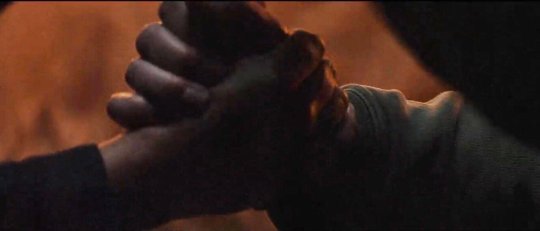
Power to the local dreamer.
|-/
18 notes
·
View notes
Text
Review : Malignant (2021)
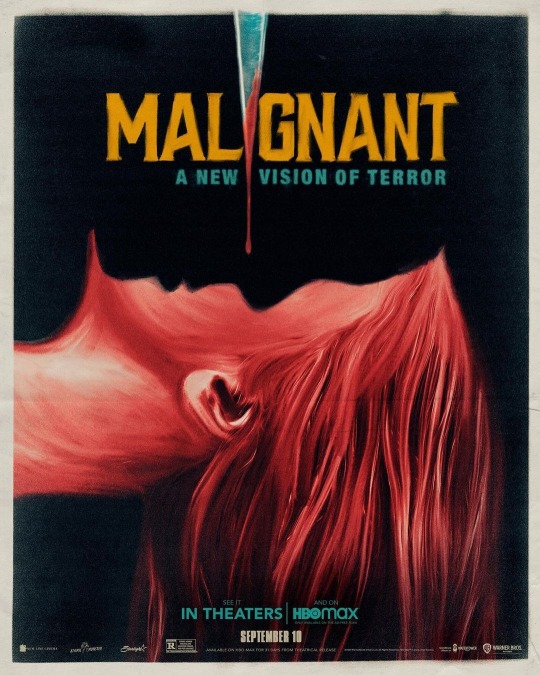
When the trailers for Malignant started making the rounds, lots of my friends got excited, but I personally did not feel a connection to the promotion. As early as release night, however, the buzz on the timeline became too big to ignore, and though the responses was varied and divided, it was consistently positive and devoid of the bashing that is so present in today’s social media sphere. Considering that I had a lazy weekend on the docket, and finding a screening of Shang-Chi and the Legend of the Ten Rings that’s not loaded to the gills is tough, I decided to jump on HBOMax and see what all the hype was about.
youtube
Malignant is the kind of exploitation that thrived in the 1970s and 1980s, attempted to find new ground in the late 1990s and the new millennium during the found-footage era, and seemingly died as horror became high brow in the run-up to the modern era. The production design on Gabriel, not to mention the alterations and costuming used for his Scorpion iteration, hearken back to the 1970s and 80s practical effects that directors like John Carpenter and those of his ilk made the horror standard. The film is deeply set in the lore of demons, phantoms and ghosts, but it also flirts with the idea of shadow people and a sort of “waking” sleep paralysis in a very interesting way that I would love to see continued in the genre. All of your standard exploitation sets are used, including the overly large home with one inhabitant, psychiatric hospitals, abandoned mansions and police stations, with some of the high-level apartments and suburban homes that killings take place in serving to modernize the exploitation elements. Even the way that the film is written steers clear of the highly cerebral and darkly suspenseful methods that Ari Aster and others go for, opting instead to lean into dialogue that props up the visual stimulus we as viewers receive while eliminating subtext.
The idea of secrets and cover-ups serves as the foundational subtext for the film, grounding it in personal suspense and deeply traumatic terror as the exploitation elements run parallel. We are given an adoption story, a misunderstood child story, a domestic abuse story and an estranged family story all within the first act of the film, not to mention higher level espionage in the opening via the explosive introduction of Gabriel. The kill list is a direct echo of said espionage, with all of the key figures in the bigger cover up serving as the fodder for Gabriel’s Scorpion form. Watching Maddie learn about her sister’s past and horrible situation allows us as the audience to have a character we can connect to in terms of taking in pertinent information. There is even a divide between Detectives Kokoa Shaw and Regina Moss that creates a rift that mirrors the different mindstates of those who believe in the supernatural versus those who are deeply skeptical.
An exploitation film the likes of Malignant has absolutely no business being as technically proficient as it is. The cinematography oscillates between calm, observant moments during the exposition dumps, but when the terror starts to spike, the camera becomes a free flowing, specter-like entity as it rotates, watches from above and generally moves with complete freedom and autonomy to be in the best position possible to maximize the fear. The general lighting very much shares the look and feel of Se7en for large portions of the film, but once the in-world lighting starts acting up and the washes of red make their presence felt, the film starts to mirror Suspiria while tonally feeling close to a film like Repulsion, but with modern day horror. The transition sequences that trap Maddie in the middle of the murders are highly stylish and well executed. Gabriel’s use of technology to communicate is extremely unsettling in its nature, as it manages to both implicate the otherworldly and interdimensional nature of the threat while also making our disturbing antagonist have a deep presence despite minimal screen time. The creeping, haunting and airy score works better than standard musical beats, and the use of old school ghost-like voices in the sound design play up the exploitation very well. Huge praise must be given to the living legend that is Zoë Bell for her top-tier stunt work as the phantom threat.
Anabelle Wallis does a powerfully understated job of carrying the dramatic weight of the film, with the premise of her adopted past and abusive husband setting the table for a deeply troubled protagonist tethering symbolic and literal ghosts with her. McKenna Grace matches the energy Wallis sets in her youthful portrayals of Maddie, with her reserved nature standing as the backstory for Maddie’s current day disposition. Maddie Hanson plays the supportive younger sister to a tee, letting her curiosity, admiration and unconditional love drive her need to protect her older adopted sister. George Young and Michole Briana White make a wonderful detective team, with Young’s naivety and need for answers playing well off of White’s deeply jaded and highly procedural outlook. Marina Mazepa and Ray Chase team up to create the unsettling terror that is Gabriel, with Mazepa’s brooding physicality creating a symbiotic connection to Chase’s instantly iconic vocal performance. Supporting cast members Jean Louisa Kelly, Susanna Thompson, Jake Abel, Jacqueline McKenzie, Christian Clemenson, Amir AboulEla and Ingrid Bisu all turn in strong performances in their smaller roles.
Based on the level of this film’s insanity, not to mention its wholehearted attempt at swinging for the fences, Malignant could have very easily been a messy, unfocused trainwreck prime for mockery. Somehow and someway, though, James Wan and company found a way to coordinate all of their chaosand turn it into something extremely visceral and unforgettable. Malignant certainly isn’t the Citizen Kane of horror films or anything, but it is EXTREMELY watchable, and if you’re willing to buy into the off the wall setup you’re presented with in the opening, then you’ll be in for quite the enjoyable rollercoaster ride.
#ChiefDoomsday#DOOMonFILM#JamesWan#Malignant#AnabelleWallis#MckennaGrace#MaddieHasson#GeorgeYoung#MicholeBrianaWhite#MarinaMazepa#RayChase#JeanLouisaKelly#SusannaThompson#JakeAbel#JacquelineMcKenzie#ChristianClemenson#AmirAboulEla#IngridBisu#ZoëBell
0 notes
Link
Apple TV+'s For All Mankind has provided an exciting alternate glimpse into world history through its first two seasons. The show, helmed by Battlestar Galactica vet Ron D. Moore, chronicles what would have happened in history had the Soviet Union beat the United States to landing on the moon in the 1960s. Those aren't the only changes to history, though.
RELATED: For All Mankind: Which Character Are You, Based On Your Zodiac Sign?
The point of divergence with the moon landing creates a ripple effect through modern history, altering world events in subtle and obvious ways. The show rarely showcases the changes, rather making them part of the overall fabric, which makes them a little more fun to discover as the series progresses.
10 The Soviet Union Landed On The Moon First

The entire premise of the series is launched when history diverges in a massive way in June of 1969. Instead of Neil Armstrong being the first man on the moon, it's Soviet cosmonaut Alexei Leonov. His success crushes American morale, much as the Soviet success with the first satellite, Sputnik, did in the early 1950s.
The show goes on to show that Apollo 11 crew Neil Armstrong and Buzz Aldrin did land on the moon, but it wasn't perfect. They crashed and were feared dead, but later were revealed to have survived.
9 Jamestown
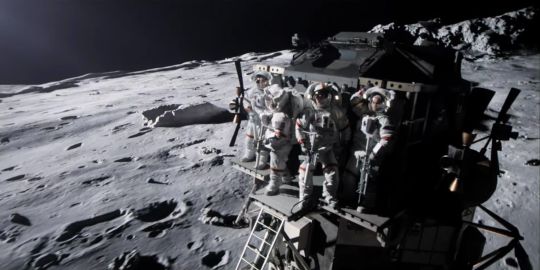
The fear and embarrassment that follows the Soviet landing motivate NASA to accelerate their plans in regards to the moon. In the show, NASA plows forward with the Jamestown moon base, which never existed in actual history. This base, launched in 1973, became the centerpiece of the American lunar program. It was added on to and expanded into the 1980s.
In real life, NASA abandoned the Apollo program after a few landings, when public interest dwindled. Apollo 13 was one of the last flights of major interest to the American public, largely because of its in-flight accident, which became the subject of a movie about the real-life space crew.
8 Women Become Astronauts Sooner

From the beginning, the Soviet cosmonaut program was far more inclusive when it came to using both men and women. The first American woman in space, Sally Ride, didn't reach orbit until 1983 when she was part of the crew of the space shuttle Challenger.
In the show, the Soviets send a woman to the Moon after the US lands there. This leads NASA to be more ambitious in including women in the astronaut corps as well. Molly Cobb became the first woman in space in the show, with Apollo 15. Danielle Pool, Tracy Stevens, and Ellen Wilson are among the others to go as well.
7 President Kennedy
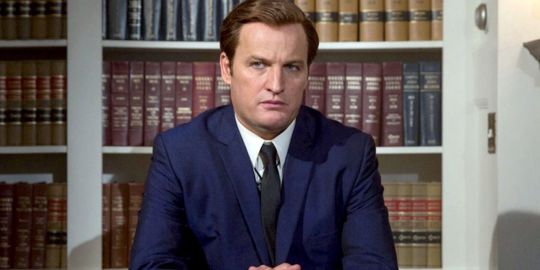
Senator Edward Kennedy ran for President of the United States in 1980 against incumbent Jimmy Carter but failed to win the nomination. In the series, he becomes President in 1973. Kennedy leaves a party on Chappaquiddick Island in 1969 due to the Soviet moon landing and avoids a tragic historical event that forever tainted his political prospects.
RELATED: For All Mankind Season 2: 5 Things Episode 1 Answered (& 5 Questions We Still Have)
Kennedy succeeded in becoming President in the alternate history of the show, but his fortunes didn't continue. His personal troubles and the successive failures of the early Apollo program doomed his re-election and led to another change in history.
6 Reagan Becomes President In 1976

Ronald Reagan was elected President in 1980 and oversaw the end of the Cold War, depicted in many excellent Cold War-era movies. In the reality of For All Mankind, he becomes President four years earlier after he defeats Kennedy in 1976 in a massive landslide.
Reagan is said to have won re-election in 1980, but the circumstances of that campaign aren't known. In the show as in real life, Reagan was bullish on militarizing space, particularly through his 'Star Wars' SDI program, which many feared would lead to nuclear war.
5 John Lennon Is Still Alive In 1983

Former member of the Beatles and legendary musician John Lennon tragically died in 1980, assassinated in front of his home in New York City. He survived in the world of the show and is shown in the second season of the series to be the advocate for peace he was in real life.
He calls for peace as the world hurtles toward nuclear conflict in the early '80s. While the outcome of the Cold War is expected to be somewhat similar, given there will be a season three of the show set in the '90s, it's not clear if events transpired exactly as they did in real life.
4 America Withdraws From Vietnam Sooner

Though the conflict with the Soviet Union becomes more pitched thanks to the moon landing, America's involvement in the Vietnam War deescalates. America withdraws from Vietnam much earlier, in 1970, a full five years before it did in actual history.
President Nixon does this in order to allow America to focus more on the space race, which they are seen to be lagging in. The fate of Vietnam is not known in the show past this point, though it likely mirrors that of real-life somewhat as the rest of the show's alternate history does.
3 Charles And Diana Don't Marry
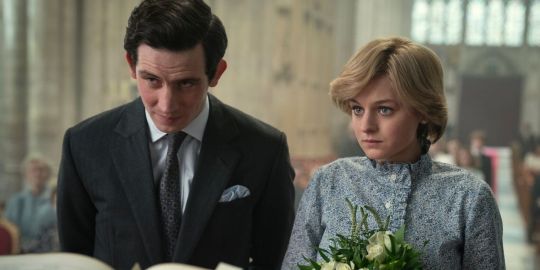
The fourth season of The Crown depicts the historical fascination with the marriage of Charles and Diana in 1981. In the world of For All Mankind, this never happened. The show's alternate history has Prince Charles marrying Camilla Parker-Bowles, his eventual second wife, rather than Diana Spencer.
RELATED: Apple TV+: 10 Shows To Watch If You Like For All Mankind
This of course would have major repercussions to established history not yet explored by the series. The couple's two sons, William and Harry, would never be born in this scenario, altering the trajectory of the royal family into the 21st century.
2 The Wrath Of Khan
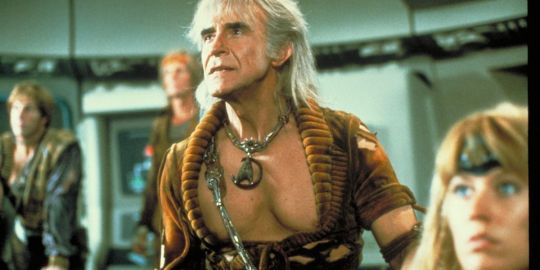
This change is fairly subtle. In episode five of the second season, “The Weight,” viewers discover that one of the greatest Star Trek movies ever, The Wrath Of Khan, has just come out in 1983. This is a slight change from real history, where the movie came out in 1982.
The movie famously changed its original title of The Revenge Of Khan due to the impending Revenge Of The Jedi, which of course was then changed to Return Of The Jedi. This suggests that Return Of The Jedi happened as is in the alternate timeline, though maybe not in 1983.
1 Mankind Lands On Mars In The 90s

A major consequence of the Soviet moon landing in 1969 is President Kennedy's commitment to beat the Soviets to Mars. This happens in the final moments of the second season finale when the show flashes forward ten years into the '90s. Fans see an American astronaut on Mars, fulfilling Kennedy's ambition and marking a massive departure from actual history.
Humanity has placed several rovers and probes on the Martian surface but remains far away from the prospect of landing a crew there any time soon.
NEXT: Chernobyl: 10 Other Historical Events From The Soviet Union That Deserve Their Own Miniseries
For All Mankind: 10 Things Different In This Alternate History from https://ift.tt/33aY0fz
0 notes
Text
On writing period fanfiction
By which I mean specific periods in time in fanfic, not the other thing.
I should probably preface this article by pointing out that this is more of a pet-peeve than anything else. It’s mostly not applicable to a good number of fandoms, as they are not tied to our real world timeline and history (though they may have timelines of their own, which means you should study their history instead) and those that are put on a ‘sliding timeline’ anyway, which covers a lot of long-runners like Marvel and DC’s universes, and I think the vast majority of fans don’t really notice or care about it in fanfic.
So, if you’re chill with that sort of thing, regardless of it you write that sort of thing yourself, I’m going to put the read-more here just so you can leave while the leaving is good.
If you’re like me and go a little feral whenever you see Harry Potter open up a smart phone app to cast a spell (yes, I have seen this done) in a fic that isn’t specifically noted as being either ‘Modern Setting’, ‘What If Harry Was Born In 2000 Instead of 1980′, or any other thing that covers that kind of setting change (or if you’re just the kind of person who likes to cover your writing bases), keep on going.
In the specific scenario of smartphone Harry, the issue is pretty easy to spot. Harry Potter takes place between 1991-1999, as far as the primary plot goes. Smartphones only became a ‘thing’ around 2002 and even then, they weren’t anything remotely like what we have today - for that, you’d have to wait until 2007-2008, when the first iPhone was released. Before that, the average smartphone instead came with a full - if miniaturized - QWERTY keyboard and apps didn’t really exist, a fact that can be confirmed by the fact that the term ‘app phones’ was actually floated for some time (around 2009) as a way of separating the older type from the newer app-capable type of smartphone.
So even the relatively recent period of 5-10 years ago can count as a specific ‘period’ so far as period writing is concerned. Which means you gotta do research.
In other scenarios I’ve seen that have also irritated me are pop culture references that don’t work, like a Buffy The Vampire Slayer YAHF (Yet Another Halloween Fic) having the characters cosplay as characters from media that doesn’t exist at that point in history (roughly 1997-1998, depending on your interpretation of various timeline clues - I favor 1997 myself) or hasn’t officially been brought to the American market - examples I have seen would be Master Chief (the first Halo game was released 2001) and Naruto (while two one-shots were around by that time, Naruto was only serialized starting in 1999 and only given an official translation in 2003, though there were scanlations before then), though I have seen many, many others that suffered from the same issues with regards to year of release.
Now, I recognize that, as mentioned earlier, this is a rather petty gripe. Like I said, it’s just as much if not more of a pet peeve for me than it is something that you need to take as gospel, though I do recommend at least trying to do research on what period of time your story is going to take place in.
Historical research can be a bit tricky. There are bits and pieces you can find out relatively easily - founding dates of certain cities, what year a certain book or play was published, general information about major public figures. Then there are things like ‘when did texting first become a thing’ and ‘what was fashion really like in this highly parodied decade’.
Seriously, that last one actually killed my attempts at an AU’d character, just because there’s so much difficulty in separating ‘stuff that’s super exaggerated about the 80′s because neons and weird clothes funny’ and ‘things that actually happened in the 80′s’, and you can’t even fully rely on media from that era either because they often distort that information as a joke or because the writers are removed from the younger generations they’re writing about.
So I suppose my best advice in this area is to be considerate of your setting, take note of what is impossible to happen then, what is possible for that time, and to do what research you can on the highlights of that era historically. There are going to be areas that aren’t covered in any place you can access and, so long as you’re putting in an honest effort, I don’t think most readers will hold any minor inaccuracies against you.
0 notes
Text
Netflix’s first interactive sitcom: Good for laughs, deserves a better app

Enlarge / In Netflix’s latest interactive special, you can tell Ellie Kemper to wield a rocket launcher. Seriously. It’s one of many reasons that comedy fans should endure the special’s quirks and annoyances.
Sixteen months after Black Mirror: Bandersnatch toyed with Netflix viewers, the streaming service is back with its second interactive TV special. This year, instead of a dark spin on ’80s video games, we get a “breakable” version of the oddball comedy Unbreakable Kimmy Schmidt.
If you come to this new interactive special hoping for one of the series’ best episodes, you’re out of luck. But if you’re less interested in wacky New York comedy exploits and more interested in how interactive television is evolving, Unbreakable Kimmy Schmidt: Kimmy vs. the Reverend might merit must-watch status—with the caveat that Netflix’s app could use an update before it streams another “choose-your-own-comedy” special.
Some people are still Schmidt out of luck
For the Schmidt-less among you: the series spent four seasons following Kimmy (Ellie Kemper), a cult escapee, as she re-acclimated to the modern world with a group of odd, new friends. While the series has officially concluded, this comeback special fast forwards to an entirely new, out-of-nowhere plot point and is therefore easy to watch for novices. She’s about to wed a British prince (Daniel Radcliffe) who had previously never appeared in the series, but the wedding planning is interrupted by a discovery that her cult captor (Jon Hamm) may have imprisoned other people.
As Kimmy goes on a journey to unravel this mystery, two other plots play out simultaneously: the prince participates in a bachelor party while Kimmy’s away, and Hollywood agent Jacqueline (Jane Krakowski) has to stall for time while her client Titus (Tituss Burgess) helps Kimmy.
A normal pedestrian choice for most people, but choosing to wait for a very, very distant driver could be the difference between life and laughs in Unbreakable Kimmy Schmidt: Kimmy vs. the Reverend.
I think most women on the verge of marrying Daniel Radcliffe would have appreciated a “why not both” option here, but, alas.
Netflix
No matter what you pick, Titus will break into song. Which song, however, is up to you.
Netflix
Certain plot points, on the other hand, won’t appear at all unless you make certain choices, which requires a complete do-over of the special.
Netflix
Chris Parnell will appear as a tripped-out festival organizer no matter how you complete this special. Well, except for one particular difference.
Netflix
How will you get from point A to point B? Maybe on bikes!
Netflix
Maybe on rider mowers!
Netflix
Maybe with Johnny Knoxville giving you the stinkeye!
Netflix
Jon Hamm and Jack McBrayer are each hilarious in this special, no matter which choices you make.
Netflix
Thus, this special’s first major divergence from Bandersnatch is that viewers are asked to make decisions on behalf of pretty much everyone, instead of a single lead character. What exactly does Jacqueline do to stall for time? How does Titus deal with a crowd of unruly rednecks? Whom does Kimmy call first with a question about her old cult life? At each divergence point, a two-option menu pops up at the bottom of the screen, which you can toggle with your remote or a touchscreen on most devices. (Sorry, Apple TV users. Even 16 months after Bandersnatch came and went, you’re still Schmidt out of luck.)
At its best, UKS revels in the moments when one of the two choices is “wrong.” Wait for a taxi that will clearly never arrive or sing an intentionally botched version of “Freebird” and a ridiculous sequence plays out before rewinding time. These moments are the golden stuff. Viewers are given no-brainer hints that these choices lead to silly, laugh-filled dead ends, and the show’s writers get the freedom to write their characters into wacky sequences that wouldn’t otherwise organically play out.
The interactive gimmick gives the writers a get-out-of-jail card for jokes that wouldn’t otherwise work outside of an animated series, and it doubles down on Bandersnatch‘s brief WTF moments of dark comedy. Explaining these moments any further would dampen their hilarity for a first-time viewer, so please forgive my vagueness.
Comedy, now loading…
But in order to make room for these moments, UKS:KvtR is forced to build a bunch of “real” plot sequences to sew the timeline together. These sometimes dull the special’s comedic punch, particularly when characters must travel from one location to the next, as if the comedy was held up behind a game console’s “loading” sequences.
Some of the special’s decisions create massive forks in story (and, thus, the gags and jokes you’ll see), which might have been fine if Netflix’s interactive format included nimbler rewind and fast-forward options. Sadly, even when you use some platforms’ built-in “go back to a specific choice” seeking functions, you’re still forced to re-watch a lot of the decision-making scenes that you’ve already seen. (These last approximately 15 seconds while the decision-making menu appears.) If you’re a completionist, you’ll have to watch some of these sequences three times to “unlock” every piece of footage in the special.
It works like an ancient Hypercard sequence.
And there’s a good-news-bad-news twist to one of my favorite decision-making moments. Sometimes, when you pick the “wrong” choice in the special, time will rewind and you’ll automatically choose the “right” thing. But other times, you’ll get to manually pick again after the rewind, and the wrong choice will still be in the menu. Sometimes, when you pick this, the results are nuts—we’re talking about the golden era of The Simpsons in terms of inspired wackiness. When those surprises hit, I found myself belly-laughing in ways I didn’t expect.
But other times, re-selecting the same choice over and over led to… the same result playing out over and over. This exposes an inherent weakness in Netflix’s system: it basically works like an ancient Hypercard sequence. Each choice links to full-motion video for both the on-screen action and your menu choices, as opposed to a dynamic menu placed on top of a separate video feed. And sometimes, Netflix doesn’t go to the trouble of building an entirely new if-then sequence. In these cases, viewers can expect a redundant feed of “pick this again and the same thing happens” choices.
An interactive drama can absorb some of these momentum-dampening moments as we watch characters ruminate or while we enjoy refreshes of stirring scenery. But a comedy set in the classic TV-sitcom mold of gags and punchlines isn’t nearly as amenable, so it’s frustrating to see some of UKS‘ most refreshing and hell-yes comedic moments hampered by this format—even though on a few occasions, the laughs are likely doubled by the effort required to dig them out.
As a comedy nerd—a devotee who ascribes to everything from Dick Van Dyke series in the ’60s to anti-comedy vanguards like The State and Mr. Show—I was charmed enough by UKS:KvtR to recommend it to anybody in a similar boat. As a kick-back-and-laugh diversion, on the other hand, the special is tougher to recommend, but most of that boils down to Netflix’s ho-hum app experience, not the cast and crew’s ambition. Go back to the interactive drawing board, Netflix, and help your next specials be a little less bitter to explore and enjoy.
Source link
قالب وردپرس
from World Wide News https://ift.tt/3dEgqbB
0 notes
Text
Time Travel Basics: PT2
So, to recap the previous entry, to build a time distortion unit, you need a particle accelerator, such as the LHC to create micro-singuarities (tiny black holes). The same facility would then capture them, magnetically, and keep them alive by feeding them enough electrons to offset the hawking radiation that would cause them to evaporate in the wild.
With the ability to produce micro-singularities for industrial use (very likely only military use, as they would not only be quite expensive to produce, but also the kind of tech a government would want to keep top secret) you simply put two of them into a housing with cathode manifolds (three way electron guns like in any 20th century color TV set) and a modestly advanced computer to control them (about as advanced as, say... a 2000s lap top).
Using the electron manifolds to manipulate the spin and frame drag of the two singularities, the unit creates two nested bubbles of spacetime, a few meters in diameter, around the unit... with positive time in the interior bubble, but negative time in the exterior bubble... moving the interior bubble backward in time... relative to the universe outside the two bubbles.
With the help of gravity sensors, to keep a lock on the Earth... because gravity can move between membranes of spacetime, the system would also be able to manipulate the distortion unit’s position in space... to stay with the Earth as moves backward through time, and thus, backward through Earth’s rotation, and it’s orbits around the sun.
lastly, this same system would be able to move the unit (and everything inside the bubbles) forward in time, just as easily as backward... simply by changing the spin of the outer bubble to a positive time spin.
Okay, so...
Here you must clearly understand that while the distortion unit is running... while those nested bubbles of frame-dragged spacetime exist around it... the unit and everything inside the bubbles ARE their own universe... and are divorced from our universe... or more specifically... our worldline, or timeline.
I’m gonna use the term, timeline, because it’s the one that has the most currency in pop culture.
So, for example, if you’re in a mall parking lot late at night, with your car parked out in a remote parking space, with your plutonium-battery powered time distortion unit sitting in the passenger seat... when you flip it on and begin moving back in time... from the perspective of an observer in the parking lot... the car will simply disappear.
Even though your car will be locked to the GPS position of that parking space as it moves backward in time, it will not be sitting in that parking space anymore. From your perspective, all will be black out the windows.
At this point, while moving backward in time, you are not affecting the main timeline in any way... other than the nearly imperceptible gravity that your car will exert on the parking lot... on the other side of the spacetime membranes.
However... the second you spin down those singularities, and re-materialize in that parking space... say, 30 years earlier... you immediately create a branch timeline.
No car materialized in that parking space 30 years ago, which means that when yours does... it starts off a different branch of history.
Which means that whatever you do in that branch timeline will not affect the main timeline from which you left.
So, going to the past to right what went wrong is not possible... well... I mean it’s possible, but it won’t affect your home timeline. So... if you’re a government, your military time travel unit is useless in helping you win that war you lost, or stop the idiot who started the war from being elected.
But it is useful for retrieving lost tech, lost footage, for learning about the past... that kind of stuff... because whatever you can grab, be it a physical object, or some video recordings, that you can fit in your car... you can take back to the future with you.
More on that some other day, but for now, we need to focus on the limitations of this kind of time travel.
For one thing, there really is no one “main” timeline. In nature, that timeline is always branching off into new ones every second, creating a kind of haystack of realities out there in the hyperverse.
Meanwhile, your time distortion unit is only so accurate.
The computer has only so much processing power, the manifolds are only so good at manipulating your singularities, the gravity sensors are only so sensitive, and your power source only has so much juice.
Also... it has to be portable. It needs to be under 100 pounds to be practical, as you may need to move it from one vehicle or boat to another in your travels in the past.
Speed, however, is also important... and here I mean, speed of time travel. How many years of history can you cover per hour, whether traveling forward or backward in time?
You can only hang out inside the pocket universe of your two nested bubbles for so many hours, as determined by how much oxygen, food, and water you can carry in the car... and you probably need enough oxygen for a return trip, as there’s no guarantee you’ll be able to refill those oxygen tanks in the past without raising suspicion.... which could lead to your arrest or detainment.
So, it turns out that the best compromise, for an 80 pound distortion unit, with reliable instruments, heavy duty enough to handle some abuse, and backward compatible enough to be repairable in the past... can cruise at about ten years per hour.
That cruising speed, of ten years per hour is the best compromise between speed, and navigation... which here means, navigation though that haystack of naturally branching timelines out in the hyperverse, through which your bubble is moving.
You could push your distortion unit to do 15 years per hour... but you would risk going off course, and materializing in a past that’s a little different from the one you were aiming for.
Instead of pushing it faster, you could set the cruise control at 10 years per hour and just hunker down for an epic 24 hour trip... sleeping a lot... starving yourself... whatever. But in that case, the sheer length of the hop would put you at risk of drifting far off course... winding up at a date 240 years earlier, that bears no resemblance to the same date in your personal history book... with untold dangers awaiting you in that... forest inhabited by bow and arrow sword people who do not understand your language sounds and know that you are a demon.
You could go slow... say 5 years per hour... and make really short hops. Stopping frequently on your way back in time to ensure you stayed on course... but that makes the return trip exceedingly complicated.
Returning to the future requires jumping a little bit to the past of your original entry point, and then following forward as accurately as possible to get you to a future that is, hopefully, indistinguishable from the one you left.
If you do multi hops back to the past, creating new branch lines at every step, then you need to retrace that path backward which... puts a lot of stress on your navigation computer, and could lead to you never finding your way home.
So, a good, by the book time traveler, will keep it to ten years per hour, and keep that trip to around five hours... with seven really pushing it.
Still, whether you’re flying by the book, or by the seat of your pants, every time traveler needs to be able to establish their “divergence,” upon landing.
Centuries ago, seafaring sailors faced a similar problem...
While exploring the oceans of the spherical planet, getting their latitude (or their north/south position on the globe) was easy... just look at Polaris... the pole star. It’s position over the horizon told you your latitude.
Higher up in the sky? You were further north. Down near the horizon? you were near the equator.
Longitude, however... or the east west position... was a hell of a lot harder to crack... and was not cracked until clocks were finally developed that could keep accurate time on a bobbing ship in a salty atmosphere with drastic changes in temperature.
For time travelers, the date is their latitude. Figuring out the date is easy. Plug a date into the computer. Follow back to that date... and after landing... verify that date by looking at the stars, grabbing a newspaper, or asking a local. Very hard to screw up the date.
But their longitude is the thing they call, “divergence,” which refers to how much the timeline they’ve landed on is “diverged” from the one they were aiming for... in other words... how different is this past from the known past?
The only way to establish divergence... to any practical degree... is to compare recordings, from the date in question, with the real time transmissions coming from those same sources now... on that same date you’ve traveled back to.
So, let’s say before you left, you brought with you a two hour recording of a local TV channel, recorded on, or before your target date. Then, after landing, you have your computer tune into that local TV station, and compare the live transmissions to the recording.
The differences in the two, will give you an idea of your divergence.
Number stations come to mind... having popped up after world war two, with mysterious wide band broadcasts at random times with seemingly random content... mostly sequences of numbers being announced, but also occasional music... but it’s not clear how many recordings have ever been made of such transmission, let alone dated and timestamped accurately.
Maybe the governments behind the number stations all have reliable, timestamped recordings... for the sole purpose of handing down to future time travelers within their ranks.
If so... then daring time pilots going back that far... to the start of the cold war, would have little else to establish their divergence... outside of print media, which just isn’t as useful when it comes to fine tuning divergence.
However, as you get into more of our modern era of the internet... you have resources like YouTube! A time traveler from decades in our future could probably have endless hours of youtube videos, all dated and timestamped from the past to have his computer compare with actual youtube on his landing date to get an extremely fine tuned level of divergence.
Weird Youtube channels like Webdriver Torso come to mind for that purpose... being completely randomized at the time of creation... but then forever set into stone once uploaded.
Any time traveler with a backlog of Webdriver Torso videos from his home line would be able to have his computer compare them to the same uploads at his landing date and calculate even extremely tiny levels of divergence.
And knowing your divergence to the best precision is key... given that after you’ve landed, you can afford to make one short, perfectly calculated hop to a much more desirable timeline... without making your return trip too complicated.
What this all means is that even the most seat of the pants, rogue time travelers... who want to make a return trip home some day... don’t dare go any further back than the end of WW2, where there was some prayer of being able to repair a failing distortion unit.
Pushing your unit to the limit, you might limp it all the way back to the 1920s, but it would be a very divergent 1920s, and you’d be stranded there.
At any rate, this gives us a kind of bell curve for time traveler traffic, with the extreme outliers being in the late 40s, early 50s... and sloping upward through the 60s, 70s, 80s, 90s, and then a big spike through the early 21st century, with more visiting the twenty-teens than any other decade before it...
...because the twenty teens just have a far more sophisticated internet than even the 2000s... with smart phones and GPS and AI, and all the rest.
So, from our perspective... what does it mean to have higher time traveler traffic than in any other decade previous?
Well, for one thing, statistically, it means that this timeline we’re living on... is NOT the main trunk that traces back to the early 20th century.
We are on a branch, of a branch, of a branch, of a branch.... created by the landings of so many different distortion units throughout our past, with each individual time traveler knowing we were just a branch, and not super caring a lot what they did to fuck with this branch during their stay.
And they are also coming in to our line from... far divergent trunk lines... some of them getting here and realizing, “Oh shit! This is waay off from where I wanted to go!”
So we are being forced off that main trunk further and further into the weird haystack of the hyperverse, while simultaneously attracting more and more divergent time travelers from even further out...
...but with everybody mingling and sharing their weird ideas from other times and other timelines, here on our internet, and in person... just as would happen in any teeming port city.
And yes, in this case, the upshot is definitely exactly the phenomenon we all agree is the signature feature of the twenty teens... namely that we seem to have collectively shifted into some alternate dimension of twilight zone craziness, where both the headlines and the tech of the day, are insane departures from the world as it was ever supposed to be.
And there’s really nothing we can do but just adapt to it.
No one time traveler is to blame, and nothing, not even a time distortion unit, can unscramble this egg.
Ultimately, this is just the natural outcome of a species like ours hitting a certain point in it’s technological maturity.
We’re gonna have all kinds of time travelers... just as we’re gonna have all kinds of AI, of varying degrees of intelligence... and we’re gonna have aliens snooping around too.
Okay... hopefully you now understand the basics of time travel, and what it meas for the modern day.
Time for me to go to bed.
0 notes
Text
Draft Research Statement
We were asked to come to the ideation workshop with 5 different ideas which could make potential GARP projects. My ideas were; Typography through time, How advertising has developed over the years, Graphic Design before computers, Advertising & Marketing and Corporate Identity. At the end of the workshop, with the help of other students ideas, I decided that I wanted to base my project on ‘Graphic Design before computers’.
The next step was to research this in more depth. Suggestions I got from the workshop were The history of graphic design/techniques used before computers, Is design better or worse now?, Better graphics for the film industry, Types of technology and what they have been used for, Can you be a graphic designer now and not use computers?, Have numbers of designers gone up and saturated the market?, Apple products, How it has affected the way people see design and Can anyone now be a graphic Designer?
I decided to make my main focus for the project the traditional techniques used in the graphic design industry. I find this topic interesting because I have never really been taught about how designers created their work before computers were introduced. I want to compare the analogue techniques with digital techniques commonly used today. I think this may be of interest to others because designers had to produce work within limitations, compared to today where possibilities are endless. When there are limits to what you can achieve, sometimes the work can come out looking a lot better compared to if you are working on a computer and you can literally create anything. This is why some people today still love using older techniques such as the risograph machine
The defined subject area of my research is ‘Graphic Design before Computers’. As a starting point for my research, I watched a documentary ‘Graphic Means’ which explores graphic design production of the 1950s through the 1990s—from linecaster to photocomposition, and from paste-up to PDF (Graphic Means, 2016). The documentary focused on graphic design processes during the 70s and 80s. It showed the major transition for the design and printing industry as centuries old procedures and machinery made way for photographic processes and eventually digital technology. I found the documentary to be very informative and interesting - I was shocked at the complexity of the procedures and the amount of steps it took to produce work compared to how fast things can be made today. I noted down the names of some designers mentioned in the film and then went and did my own research online about their work and techniques. My favourite examples are Gunter Rambow (unique designer who created engaging and political posters) and Leonard Koren (producer of 70s California New Wave Magazine). I have since done some broader research, looking into more designers who used similar techniques. I have been fascinated in the psychedelic posters produced by Wes Wilson in the 60’s who used lithograph techniques. He created posters for huge bands such as The Beatles and The Doors. “Wes Wilson single-handedly pioneered what is now known as the psychedelic poster. His style of filling all available space with lettering, of creating fluid forms made from letters, and using flowing letters to create shapes became the standard that most psychedelic artists followed.” (Erlewine, 2019). The image to the right shows the first clear example of this, the poster BG-18. This was created for a show with the Association at the Fillmore Auditorium. Set in a background of green is a swirling flame-form of red letters.
Since getting feedback about my research, I was advised to look more into the technical side of the different techniques used rather than focussing too much on comparing different visual styles. I have also done some research into skeuomorphs as I find this concept really interesting. It links an object or feature to the design of an older similar object. An example of this would be deleting files on your computer. “When computer manufacturers decided to move their machines from the clutches of techies into the jittery hands of the general public, they thought skeuomorphic graphical user interfaces would make them comfortingly familiar. That crumpling paper sound is very satisfying.” (Herman, 2014). The universal icon for erasing computer files is a trash bin, there is no real reason for this other than it giving the user a feeling of familiarity. Sounds can be skeuomorphic too. Camera phones don’t have mechanical shutters, but the electronically produced click reassures users that they’ve “snapped” a picture. Another example is they way people edit their photographs in certain ways in order to give them a vintage look. It is very popular nowadays on Instagram for people to add filters which give their photos a grainy effect, to give the illusion that it was taken on film. “We tend to associate sepia tones with nostalgia. Over exposed, light leaked photographs are reminiscent of the kaleidoscopic properties of memory – oscillating between moments and images in a blink. In our childhood we saw through the same eyes as we do now. With hindsight, the mind’s eye distorts the scale, saturates the colors, blurs some things and enhances others.” (Lembke, 2015).
Another subtopic I wanted to look into was the timeline of popular design methods techniques and look into where things became mostly digital. It is hard to pinpoint a specific date because to this day, people still combine old and new style techniques in order to create their pieces of work. You could look right back to the stone age and talk about the design techniques of cave paintings, however I am just going to stick to the modern era of design. Early Modern design styles emerged from the 1900s. Paste up was preceded by hot type and cold type technologies. “It took a steady hand, good eye, and the use of very toxic solvents and razor sharp cutting tools.” (Schneider, 2012) It starts with a layout board, a pre-printed board with non-reproductive blue lines. These were then pasted on more layout boards, to be shot again into film, that would be turned into a printing plate to print a magazine, poster, or flyer. This process took a huge amount of time longer than what we now do with simple strokes and keyboard commands on computers and are either digitally printed or go live in digital format onto the web. Starting in the 1990s, many newspapers started doing away with paste up, switching to desktop publishing software that allows pages to be designed completely on a computer.
In the 1980’s in Japan, the Risograph machine was invented as a quick, cheap, and easy way to make multiple copies, and since adopted by the art and design community for its low cost, speed, and versatility. Creating Riso images is similar to screen printing in terms of color separation and ink transfer, but with the rough-and-ready results of an office photocopier. The riso machine is a great example of how a lot of designers love working to limitations.
I think a gap in my knowledge is whether there are still many designers today who prefer to use the traditional techniques to this day rather than using computers. I want to find designers who prefer working to those limitations. I have found a couple of books which I am interested in reading over summer. I plan on reading ‘Know Your Onions: Graphic Design’ by Drew De Soto and ‘100 Ideas that Changed Graphic Design’ by Steven Heller & Veronique Vienne. Both of these books are recommended for design students as they talk about the history of graphic design methods, which is relevant to my topic.
However, I still need to find more reading materials to support my research. I also want to do a lot more in depth research about the technical side of the techniques, as well as discussing how boundaries can improve design. When using software like photoshop or illustrator, possibilities are endless. However, freedom isn’t always a good thing. When faced with a brief, you are left thinking “What should I do?” instead of having the mentality of “What can I do?” (O'Nolan, 2010). An example of how limitations can improve design is colour. When you have a limited colour palette, the piece looks more consistent. Using a huge range of different colours in your work makes it harder to portray a solid identity. Also, limiting typography is similar to colour. “Restricting our use of typography contributes to a better and a stronger overall design.” It can become confusing if you use a number of different fonts in your work. Instead, it is better to limit yourself to just one or two fonts. Apple products are a good example of how using limitations can create something extremely successful. Apple uses minimalism, which means they take normal limitations one step further to create such clean, simple products. However, limitations are not always a great thing for design. You need to know how to use them to your advantage. The more boundaries you have, the more of a challenge it can become.
I still need to find out more information about the technical side of some of the design methods. I also would find it interesting to dig in deeper looking into skeuomorphs in the design world as I find the concept of them really interesting, and questioning whether skeuomorphs will eventually go out of fashion as time moves on. Mostly my methods of research over summer will be through reading books and finding online articles. If I find a designer relevant to my essay who still uses certain traditional techniques in their work today, it may be a good idea to interview them about their work as a possible method of research. If I do this, there will be ethics issues that I will need to consider. Over summer, I aim to continue my research through reading and updating my tumblr blog so I am in a good position to continue when I return to university.
0 notes
Link
In an excerpt from Wray Vamplew’s Pay Up And Play The Game, first published in 1988 (and passed on to me by football historian Gary James), a study reveals that all the way back in 1910 Manchester City and West Ham United had the highest percentage of semi-skilled manual and unskilled manual workers who were shareholders in their club.
These percentages far outweighed those of other clubs who became limited companies during that era, namely Liverpool, Everton, Newcastle, Arsenal and Tottenham. There were others, too, and all had majority shareholders who were ‘proprietors’ or in clerical occupations.
This illustrates that in Edwardian England, West Ham and Manchester City had more working class supporters of any clubs across the land, meaning that even though 200 miles separated the two institutions they were anything but a class apart. Furthermore, there was another key commonality, as supporter Mark Meadowcroft explained to me: “It’s about the culture of Eastern ends of big cities. The sort of people that lived downwind of the factories.”
Fast forward through the decades to May 9th 1987 where the stage is Upton Park and it’s the final game of the season. City were all-but-down prior to kick-off and now relegation is confirmed after a fabulous Hammers side containing the likes of Devonshire and Cottee easily win out 2-0.
Having sung their hearts out for the entirety of the ninety minutes the City supporters now fall silent, contemplating their plight but collectively rouse themselves once again at the sight of the home fans streaming over the advertising hoardings and heading their way. This is 1987 remember and hooliganism is at its peak so the harder lads in the away contingent prepare for battle while the rest resign themselves to a thoroughly miserable end to a thoroughly miserable day. The police too are on full alert as a mass of Hammers assemble.
Only there is no invasion of the away end. Instead the West Ham fans stand on the pitch and sing ‘loyal supporters’ towards their northern counterparts. This is swiftly followed by a rendition of ‘we’ll meet again’ accompanied by applause that is soon warmly reciprocated once confusion abates. Finally there is the fait accompli of bonding anthems as the home fans loudly chant ‘We only hate Man United’.
Stories abound from City fans of how they were well-wished all the way back to the tube station that day and from there forward an affinity was born between each club’s fan-base; an affinity that was always previously present but never really spoken of and certainly not acknowledged; an affinity rooted in their roots.
But let’s not get too hippy-dippy here and suggest that it’s exclusively wine and roses and the rare instance of a wholly harmonious relationship between two rival sets of fans. In amongst the avalanche of positive comments amounting to mutual admiration I received when I brought this subject up online this week, were examples highlighting that animosity still rears its head in the modern era from time to time while you’d have to be frankly insane to relish a trip to Upton Park in the 70s and 80s during the reign of the feared ICF.
Similarly, it would take a Hammer of a certain disposition to enjoy the prospect of navigating the narrow alleyways of Moss Side during the decades when violence was prevalent.
Playmaker FC’s American Soccer Fan give his take on all six ‘field goals’ during West Ham 4-2 Burnley…
Yet it can still be truthfully said that an unusual connection exists between the fan-bases – one founded on respect and an appreciation of their similarities – and crucially it’s a connection that has sustained through not only football’s extreme make-over in recent times but a complete transformation in circumstances for one of the clubs.
We all know what that transformation was and assuming you’ve spent more than a singular passing browse on Twitter you’ll know too how the takeover of Manchester City in 2008 transformed not just their bank balance but their image too. From being commonly viewed as pretty likeable all told and even a second club to casually root for, they are now damned and demeaned at every turn for their nouveau wealth as the tribalism of the terraces switches to social media.
That, however, is anything but the case with West Ham and from a personal perspective as a Blue I’ve lost count of the occasions my timeline has been awash with criticism of my club and just as I’m losing the will to live along comes a solitary tweet beneath an avi of two crossed hammers defending them.
Free from jealousy the tweet will invariably state that City supporters deserve their good fortune after sticking by their team through thick and thin and generations of mediocrity, and invariably too there will be the inclusion of a word, one that is fundamental in explaining why both sets of fans get on. It’s a word that kept on appearing from the hundreds of replies I received from up north and down south this week and that word is ‘proper’.
Proper club. Proper fans. Grounded. Authentic. And the insinuation of course is that other clubs – namely each club’s local rivals – are not so. Instead they are the glitzy media-darlings who kept West Ham and City in shadow as we grew up. They are the ones who attract the day-trippers. They are the ones who inherently possess an arrogance that is unbecoming.
If that is the sharing of demographic there is also a sharing of heroes that exceeds the norm in number. From Malcolm Allison and John Bond being formative in the ‘West Ham Way’ before both going on to manage at Maine Road to Pablo Zabaleta’s warrior-spirit being mutually cherished, there is a long, long list of individuals who have been fortunate enough to experience the two clubs and so naturally with such combined lineage there comes communion.
Regarding our neighbours, an enemy of an enemy is a friend. Regarding the stars who lit up Upton Park, Maine Road, the Etihad and the London Stadium, our values merge.
And that ultimately is what it comes down to when all is said and done: the affinity, mutual respect, call-it-what-you-like between the fan-bases of West Ham and Manchester City is forged on a merging of values. It is like recognising like. It is class recognising class.
0 notes
Link
THE HEAVY COVERAGE of North Korea’s missile program has managed to gloss over a crucial aspect of the story — the awful reality of nuclear war. It remains in the abstract, perhaps because any magnitude of the deaths of millions is too much a statistic to truly comprehend.
Jeffrey Lewis’s new novel, The 2020 Commission Report on the North Korean Nuclear Attacks Against the United States, is the gut punch everyone needs. The author is one of the world’s foremost nuclear arms control experts, but instead of the usual wonk’s work, he has chosen to write what he dubs “a speculative novel,” an imagined report investigating how nuclear war happened, along the lines of the task of the real 9/11 Commission.
Reading the entirely believable language of bureaucracy unnerved me and, at points, left me physically ill. Nuclear missiles rain down on South Korea, Japan, and the United States, killing three million people in 48 hours, with millions more dying in the subsequent days, months, and years. Lewis writes:
With the widespread destruction and collapse of infrastructure, millions of people began to simply walk out of the destruction zone. Over the course of the afternoon and well into the night, millions of people walked along expressways and over bridges to escape the misery and suffering within the cities. While many eventually made it home after walking ten or even twenty miles, many tens of thousands did not, falling along the way; the escape routes were littered with the bodies of men, women, and children.
As someone who has covered devastation, albeit natural ones such as earthquake disasters, I found Lewis’s descriptions jarringly recognizable, the dislocation of modern-era survivors, suddenly left not only without water, but without cell phones and the internet — without information — wandering people in a shattered state of trauma and loss.
His accounts also recall John Hersey’s stories in Hiroshima, and that is deliberate. Lewis has said Hersey’s book has been most responsible for the professional path he has chosen.
But before any of the devastation, he first takes us on the entirely conceivable set of circumstances that leads to the moment when Kim Jong Un decides to strike.
The Trump administration has greenlit a secret psychological operation, a compromise with White House hawks who preferred a “bloody nose” approach. Bombers would fly toward North Korean airspace only to turn away at the last moment, keeping the North on edge.
A confluence of events comes together. American and South Korean joint military exercises are underway. A commercial flight, BX 411, sets off from Busan to Ulan Bator (this route exists). The cockpit loses power for a few minutes from a known Airbus A320 issue. This is also real, and Lewis includes the citation from the National Transportation Safety Board about the problem at the end of his book (there are more than 250 citations in this “novel”). North Korea detects the plane on its radar, flying without a transponder during the few minutes when it has lost power, and decides to shoot down what it believes is a bomber.
This is fiction, but it is grounded in wonky detail. As South Korean officials debate an appropriate response to the plane’s downing, Lewis reminds us of how hamstrung they can feel. South Korea’s military remains technically under American control, and Lewis notes the dramatic 2017 defection of a North Korean soldier across the DMZ, when South Korean soldiers could not return fire. Later, he provides other real details, including the 20 minutes it took for staffers in Seoul to assemble in the subsequent emergency, basing his timeline on what really happened during the 2010 North Korean shelling of a South Korean island.
And of course, there is death by Twitter. How plausible would it be for Kim Jong Un, in a certain context, to misread Trump’s tweet, carelessly sent one morning from Mar-a-Lago: “LITTLE ROCKET MAN WON’T BE BOTHERING US MUCH LONGER!” This is Lewis’s fictional side, but disturbingly, it hardly feels like much artistic license.
At many points, I was seized with the desire to pop Lewis’s book into a FedEx envelope addressed to “Kim Jong Un, the Ryongsong Residence, Pyongyang.” It is a must-read for the players actually involved, from Kim to those in the Trump, South Korea’s Moon, and Japan’s Abe administrations. It is scheduled to be translated into Japanese, with Chinese and South Korean publishers still deciding.
What Lewis does so well is show the geopolitical impact of human judgment and error, made by men who just happened to end up in the offices of national decision-makers. “We now know that, although every one of these events was detected, assessed, and promptly passed up the chain of command, the overall system did not work as intended,” he intones.
In the first 18 months of his presidency, Trump has managed to avoid a true global crisis, the kind that inevitably tests every president at some point in his term. This is a book as much about nuclear disaster as it is about the temperament of President Trump. Lewis’s commentary is unsparing on the latter. Trump is on his fourth chief of staff and fourth national security advisor. His chief of staff devotes much of his time managing up, working around the president’s Fox News and golf schedule. These circumstances contribute to the role the United States plays as the characters stumble into nuclear catastrophe. As mercurial as President Trump is, he is also oddly predictable, and Lewis builds a believable man with his ego, irritability, and carelessness.
Four years ago, it was impossible for most Americans to imagine Trump as president. And so perhaps a book about nuclear disaster, based on 80 percent facts and 20 percent imagination, ought not to be dismissed. As the pretend voice of a commission looking back at a war, Lewis writes with what sometimes feels like dispassionate urgency, other times with plaintive emotional depth. This book is a warning for us, in a climate where life too frequently imitates art.
¤
Melissa Chan is a national and foreign affairs reporter based between Berlin and Los Angeles. She is a collaborator with the Global Reporting Centre and a term member at the Council on Foreign Relations.
The post The Terrifying Truth in Jeffrey Lewis’s Novel on Nuclear War appeared first on Los Angeles Review of Books.
from Los Angeles Review of Books https://ift.tt/2O31ZVr
0 notes
Text
Arcade fame turns to infamy as Billy Mitchell’s record-setting Donkey Kong score is invalidated
Arcade fame turns to infamy as Billy Mitchell’s record-setting Donkey Kong score is invalidated
The record-setting score that settled the Donkey Kong arcade rivalry, made famous by the documentary The King of Kong, has been invalidated by Twin Galaxies, the de facto arbiter of arcade world records. What’s more, Billy Mitchell, the occasionally controversial player who set the scores, has been permanently banned from consideration for future records.
It’s a huge upset that calls into question decades of history. Will other similarly disputed scores get the ax? Are any old-school arcade legends safe?
Before anything, it should be noted that although this sounds like kind of a random niche issue, the classic gaming scene is huge and millions follow it closely and take it very seriously. Breaking a high score on a 30-year-old game or shaving a quarter second off a record time can and will be celebrated as if the player has won an Olympic medal. One can never underestimate the size or sincerity of online communities. Cheating is, of course, not tolerated.
With that said, it’s worth considering that Billy Mitchell’s case is unique. He is undoubtedly a highly skilled player and has been setting records since the ’80s. But, as anyone who watched The King of Kong will have learned, he’s also a bit shady and his Donkey Kong acumen is far from established.
The issue is simply that despite having provided tapes of games setting records — including being the first to break a million in Donkey Kong — no one has seen him play like that in person.
That may sound like a red flag, but in the speedrunning and record setting community a great deal of practice happens alone, in an empty arcade, or otherwise with no credible witnesses (though Twitch has changed that). You could set a world record while in the zone after getting home from work, but it doesn’t count unless it’s reviewed and accredited by a neutral party. Twin Galaxies is the largest organization performing that duty and they take it very seriously indeed.
The final score on Mitchell’s disputed tape showing in The King of Kong (the leading 1 is omitted because the digits roll over when you reach a million).
You may remember that at the end of The King of Kong, Mitchell reestablishes his supremacy over plucky local kid Steve Wiebe with a “direct capture” tape of a run scoring 1,047,200 points. There are no witnesses to this game. Shortly after this, he also recorded a 1,050,200 score, also not witnessed. And just a week before being inducted into the International Video Game Hall of Fame in Iowa, he set records in both Donkey Kong (1,062,800) and Donkey Kong 2.
Now here’s where things get dicey (and nerdy).
Jeremy Young, aka Xelnia, put together the official two-part complaint on Twin Galaxies. For one part of it, he mentioned the suspicions some already had regarding the evidence set forth of the last and highest score Mitchell set, in an arcade called Boomers.
As others had already pointed out, not only are the run itself and resulting score not shown in the video, but the referee is among the least reliable, the timeline is unclear, among other things. Most damning, however, it is clear that when Mitchell’s confederate ostentatiously “swaps out” the Donkey Kong board (so it can be verified elsewhere) for a Donkey Kong Jr one (which Mitchell supposedly later set a record on), both PCBs were in fact the latter.
Twin Galaxies user Robert.F explained the differences in charming internet forum argot:
to a UN-trained train eye Dk and DKjr look the same and in fact they are vary similar, except for a few noticeable differences…the DK pcb has white text on the pcb and the Dk jr has banana yellow text printed on the board ,, the DK pcb is 1/2 digital and 1/2 Analog sound and there is a adjustment pot on the dk pcb for the Analog sound`s, The Dk Jr board is fully digital and has no Analog sound adjustment pot in the exact same position on the dkjr board, and the 3rd noticeable differences and you will see; it if you review the video carefully Dk has the same ROM socket lay out and the same number of sockets as a Dkjr pcb ,, But DKjr has one of them ROM socket empty ,,,,,,
But these circumstantial issues could be explained as a bit of confusion in the moment, a misspoken word in their excitement, and so on. Fortunately, that wasn’t the extent of the evidence.
As you may know, emulators are a type of application made to run old software (like arcade games) as closely as possible to how it ran on the original hardware. MAME is by far the most complex and perhaps the best known emulator; this amazing app can emulate everything from Donkey Kong to much more recent games with complex 3D graphics. Of course MAME runs aren’t accepted for world records — you could easily manipulate the software or even the game data itself. Real arcade hardware is required.
But MAME isn’t perfect; there are tiny differences in how it displays graphics — things you wouldn’t notice unless you were watching a game frame by frame looking for them in particular.
Which is exactly what people started doing with Mitchell’s no-witnesses, only-on-video scores.
It turns out that the original Donkey Kong PCBs had a specific method of rendering a scene during graphics transitions called a “sliding door effect,” distinctive in the pattern of how pixels are updated. But careful inspection of Mitchell’s tapes showed not a sliding door, but instead a distinctive artifact of MAME emulation whereby the frame is rendered in chunks according to how the data is loaded from memory.
You can see the similarity in the GIFs below, provided as evidence by Young.
First is footage of an actual machine taken at 60FPS. Note the diagonal “sliding door” that reveals the scene from the top left downwards:
Next, Mitchell’s 1,050,200 run:
Last, how MAME renders a similar scene:
See how the ladders come in all at once in that pattern, and there’s no sliding door? As you can tell, it’s something of a smoking gun. Certainly Twin Galaxies investigators thought so. In their conclusions, issued today on the forums, they wrote (emphasis theirs):
The taped Donkey Kong score performances of 1,047,200 (the King of Kong “tape”), 1,050,200 (the Mortgage Brokers score) that were historically used by Twin Galaxies to substantiate those scores and place them in the database were not produced by the direct feed output of an original unmodified Donkey Kong Arcade PCB.
They decline to go so far as saying they know it was MAME, but that’s a mere scruple — everyone understands it’s the most likely situation. Regardless, the very fact that Mitchell passed off non-authentic footage as real is more than enough to strike his scores and, as they also announce, ban him from further placement anywhere in the system.
Mitchell, who has remained out of sight during the investigation that has gone on these last few months, has essentially been ruined for good in the arcade world. Even if he were to set a world record today (and existing record holders doubt he has the skill to do so based on reviewing his play), it would be tainted by years of proven deception. The community won’t forgive him.
And that’s the worry others are voicing: will the investigators come for other scores that for years have been venerated but have not been verified as strictly as modern records are? Will, for example, any score without an accredited witness or reliable recording be removed from the lists?
In their decision, Twin Galaxies’ authorities write:
Twin Galaxies is dedicated to absolutely rooting out invalid scores from our historic database wherever we find them.
Our methodic approach has allowed many things to surface, not only related to this specific score, but other scores as well as some previously never-before-discussed video game related history.
We must repeat, the truth is the priority. That is the concern. Whatever it takes.
This dispute is closed, and a controversial but nevertheless legendary gaming figure covered in shame (or he should be if he has any). Who will be next? Regardless of who falls, the community will no doubt continue to thrive; the passion for these old games is undying and as new generations have shown, not limited to an aging cohort of Gen-Xers striving to extend a bygone era of glory (though admittedly they are a big part of it).
If this strange saga interested you anywhere near as much as it interested me, go ahead and dive in. You might find you have a new hobby. Just don’t try to fake it. And by the way, the current top score in Donkey Kong is 1,247,700, set just two months ago by Robbie Lakeman. Good luck.
0 notes